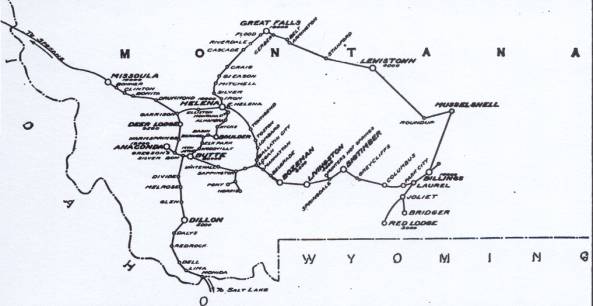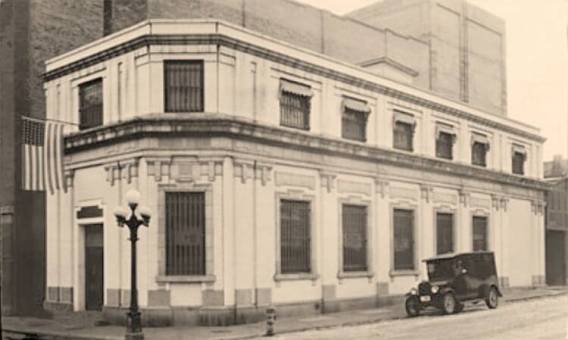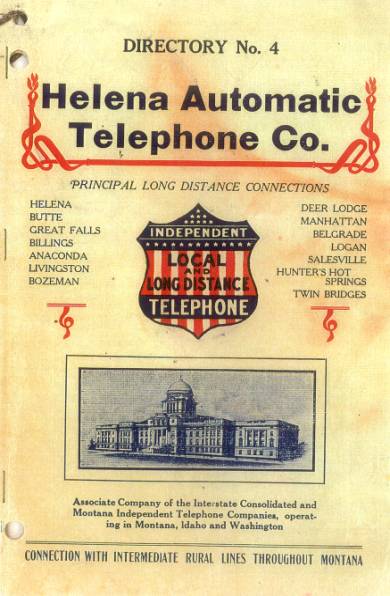A Tale of Two Telephones:
Competitive
Telecommunications in Early 20th Century Montana
Óby Dan Elliott
Unabridged
Account especially for DialMontana.com
May 8 with May
28 revisions--2012

“Do you know,
have you had occasion to learn, that there is no hospitality for invention
nowadays? There is no encouragement for
you to set your wits at work to improve the telephone, or the camera, or some
piece of machinery, or some mechanical process; you are not invited to find a
shorter and cheaper way to make things or to perfect them, or to invent better
things to take their place. There is
too much money invested in old machinery; too much money has been spent
advertising the old camera; the telephone plants, as they are, cost too much to
permit their being superseded by something better. Wherever there is monopoly, not only is there no incentive to
improve, but, improvement being costly in that it ‘scraps’ old machinery and
destroys the value of old products, there is a positive motive against
improvement.”
President
Woodrow Wilson in “The Emancipation of Business”
(The World’s
Work, June 1913, vol. 26, p. 185)
Prologue
The first telegraphic dots and dashes in Montana were heard tapping
at its territorial capital of Virginia City in 1866. This three-decade-old marvel, the reigning gold standard for
fast, longer distance communication, famously was initiated with inventor
Samuel Morse’s message “What Hath God Wrought!”. A telegram was a much faster, less private version of millennia
old letter correspondence received or sent by mail carrier, although most often
it would be impersonal, abbreviated and reserved for important matters. Like
mail correspondence, a telegram didn’t barge into one’s home from the ethos as
an uninvited electronic visitor --- it properly was hand delivered at the front
door. Telegraphy was a comprehensible,
significant first salvo in establishing a new communications paradigm: it imbued residents in remote places like
Virginia City with a current sense of the world afar, and it gave birth to an
electronically-based age in which people would expect a new wealth of more
information, much more quickly.
This matter of expectation soon would change again starting just a
decade later in America’s centennial year when the telephone was patented. It would transform the leap in
communications started by the telegraph into a new interactive information age: Its frequent long distance communications
were practiced within one’s home, in real time, by interacting and natural
sounding virtual voices. It was a
tool in which inventors took another decade initially to explore, and at least
that long for the public to become somewhat acclimated. Meanwhile, capitalists and corporate
executives were devising strategies for its profitable use, beginning in the
Age of Empire and extending into the cusp of the Populist and Progressive
periods.
The account following features a brief supercharged subset of
these periods in which competitive telephony would prevail in Montana at the
beginning of the 20th century from 1907-1912---just after Bell’s original telephone patents had expired late in the
19th century. The story begins with a
strong competitive push that quickly resulted in significantly more
telecommunications in Montana, some of it on the cutting edge for the
time. It unwinds unfortunately when
competition is squelched...and monopoly resurrected. The deconstruction begins with corporate overextension,
shenanigans and deceit. Ultimately,
main actors in this tale claim the dubious distinction of being named principle
defendants in the first ever antitrust action brought by the U.S. government
against the telecommunications industry.
An unintended consequence for seventy ensuing years, after quick
settlement of the litigation, was the attenuated development of the information
age in America and Montana.
A Terse Introduction to Automatic
Telephony, and Our Main Character
Less than a month after President Cleveland signed the Montana
statehood bill on February 22, 1889, a Kansas City undertaker named Almon
Strowger filed his patent application on March 12th for the first automatic
telephone switch. The new patent was
approved two years later—just a couple of years before Ma Bell’s original
telephone industry patents were set to expire. (Source: 2) (Link to Footnote A) A1
Telephone service had been provided for a dozen years prior by the monopolistic Bell system, also known as “Bell” or eventually the American Telephone and Telegraph Company (ATT), or, with no love lost, nicknamed the Octopus. Why? Because its tentacles were into everything even tangentially related to providing telephone service: Politics, court cases, franchises, newspapers, you name it, they were involved. (Below is one depiction of the Bell monopoly of the day.)
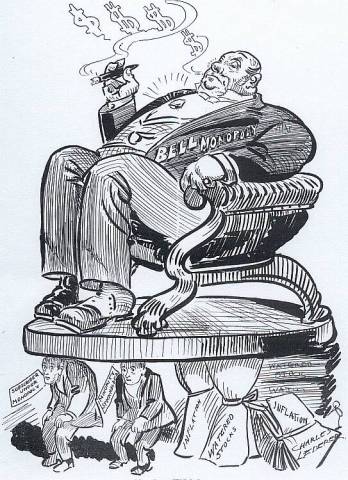
The Bell organization was comprised of a federation of local
exchange companies (in Montana known as the Rocky Mountain Bell Company or
RMBC), long distance toll operations connecting the local exchange companies
and equipment operations. The regime
knew it would face competitive headwinds with the expiration of Alexander
Graham Bell’s original telephone patents in 1893-94, and it had planned
accordingly, as we shall see. These
years of economic depression saw the telephone industry in America thrown open
to twenty years of competition, sometimes knuckle-hard, which resulted in
innovation and significant expansion of areas being served and customer
numbers. (Learn more about the history of the Bell System at this link: Bell System Sidebar) BSS
Strowger’s automatically switched local calling, and the dial
telephones complimenting it, would play a key role in this new competition,
innovation and expansion. His automatic
switches, compared to the manually switched operator-based calling of Bell,
were advertised to be “girl-less, cuss-less, out-of-order-less and
wait-less”. These words resonated with
meaning to the consuming public because callers were connected much more quickly,
calls were confidential and callers were relieved from having to interact every
time they placed a call with a third party, that being one or more
unpredictably impersonal, arbitrary or even pernicious, sometimes cutesy,
perhaps too curious, over-worked and inadequately compensated operators. In fact, an operator intentionally
connecting callers with his main competitor’s undertaking business spurred
Strowger to invent the automatic exchange switch; the operator was his
competitor’s wife. (Source: 2)
Within a dozen years, the company producing Strowger’s invention,
the Automatic Electric Company (AEC), was operating a six-story headquarters
and manufacturing plant in Chicago. Its
early 20th century automatic switching and dial telephone products were
tailored for sale to newly emerging Independent telephone companies
constructing local exchanges in their attempt to compete with Bell’s older,
less economic technology. So how did
this affect Montana? We’ll first need
to visit Ohio and New York. (Source: 3)
It was in the dawning of the 20th century that a bright young
entrepreneur named Thaddeus S. Lane began developing his skills in the newly
competitive telephone industry. He was
born on a Gustavus, Ohio farm on February 10, 1872 to Truman M. and Melissa
Lane, hearty descendants of colonial America who drove an ox team to the rural area. After high school, Thaddeus taught school
briefly before taking a job in telephone manufacturing. His marriage to Miss
Lilian Payntar at New York City in 1897 soon produced one daughter,
Lilian. With his native talents still
undeveloped but in the ready, the stage was set for Thaddeus. One may wonder how this modest beginning
would lead him to embark on a highflying career befitting the era’s cleverest business
elite, but that is indeed what would occur. (Sources: 5, 64A)
Thaddeus Lane’s manufacturing experience led him, with three other
Ohioans, to apply in 1901 for an Independent telephone company franchise at the
town of Jamestown, New York. The
Independent local exchange would compete with the Bell system. Within two to three years his Independent
telephone operation, the Home Telephone Company of Jamestown, effectively was
rivaling Bell operations in the area.
Part and parcel of successfully competing with Bell inevitably involved
skirmishes with its well-oiled publicity machine. As Lane’s prominence grew, so did the size of his target. (Source: 6)
Bell’s early 1904 publicity campaign in over a dozen New York
newspapers targeted N.Y. Independents, including Lane. His response in the Jamestown newspaper was
reprinted in the national journal Telephony in February 1904. In it he demonstrated his gift of logical
expression often used to hoist an opponent by his own petard, his understanding
of Bell’s tactics and his first mention of Montana telephony: “A few failures of Independent telephone
companies are noted, although to find them the Bell company has been obliged to
go as far west as Montana and as far south as Georgia. Some of these failures have been advertised
by the Bell company no less than thirty-seven times, from which it would appear
that material for this style of advertising is somewhat scarce. It will be noted that the Bell company, in
its advertising, makes no claims of superior service, but on the other hand
confesses that it has not been equal to the occasion: has not been able to meet
competition, and has permitted its competitors, the Independents to occupy and
develop territory in many sections of the country driving the Bell company
entirely from the field.” (Pictured
below is the generic Independent Telephone Association logo.) (Source: 7)
(Link to Footnote B) B1
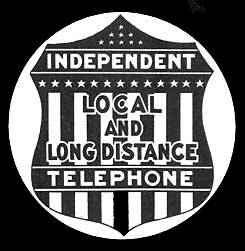
Although Mr. Lane’s New York operations were located in a
competitive Independent company v. Bell system hotbed, by 1906 he had expanded
and was thriving as an owner, director or manager of forty-two telephone
exchanges, secretary of the New York Telephone Association and delegate to
International Independent Telephone Association conventions. He was well connected in the avant garde of
the burgeoning Independent company industry, even in a broadly regional,
perhaps national way. (Source: 8)
Transition to
Montana
This notoriety, which had garnered the attention of a leading (but
unidentified) Butte citizen at some important juncture, would have significant
consequences for Mr. Lane, and Montana.
The Buttian had attempted in early 1906 to call long distance over RMBC
lines, Salt Lake City to Butte. When
billed for this call that was never connected, the man repeatedly refused to
pay, that is, until RMBC threatened to terminate his telephone service in
Butte. This irascible incident resulted in a Butte brainstorm: Bell in MT
needed a good lick of competition. The
man, with quick dispatch, contacted a bright, aggressive and young New York
acquaintance: Thaddeus Lane. After
“conferences” with Butte businessmen, the adroit Mr. Lane “was induced to come
to Butte”. (Source: 9)
Timing in 1906 for a move to Butte would be propitious for T.S.
Lane. A brouhaha of sea-changing
proportions was playing out in New York between large moneyed, but poorly run
and nearly defunct Independent telephone interests, and even larger moneyed
Bell interests. New York’s attorney
general had pushed Bell interests from the catbird’s seat by exposing a
secretly proposed anti-competitive sale of the Independent company properties
to a Bell intermediary. Bell had lost
the round, but so had the Independents because their big eastern money-center
financiers significantly were vested in the large, strategic sale. A lingering, deleterious effect on
Independent companies across America was a narrower choice of financing options
from which to choose; even watered stock and ponzi schemes would be used---this
requirement would affect Montana.
Whether he intended it, Lane’s operations had been ensnared in the
peripheries of the bruising match, with local investors assuming a controlling
interest in the Jamestown Home Telephone Co.
Indeed, it was a good time to “Go West, Young Man”. (Sources: 10A, 10B,
10C, 10D, 10E, Horace Greely)
Also fortuitous for T.S. Lane as he arrived at Butte were two
Montana Supreme Court cases clarifying governmental requirements for new
telephone companies desiring to operate within cities and towns. In Rocky Mountain Bell Telephone v. Mayor of
Red Lodge and Crumb v. City of Helena, March 26, 1906, the Court overturned as
unconstitutional the 1905 Legislative enactment that excluded rights-of-way
within cities and towns from the statewide requirement allowing utility
construction in rights-of-way. With these decisions, municipalities were
obliged to grant franchises to potential new competitors like Mr. Lane, if they
could provide a modicum of proof that they were capable of providing
service. (33 Mont 45, 34 Mont 67)
The Crumb in the Helena case was the W.H. Crumb Company of
Chicago, a telephone equipment manufacturer.
It was Crumb’s intent at the time of the court case to construct
exchanges in Great Falls, Helena and Bozeman, with another Independent company
to operate in Montana cities further south and west. However, company owner W. H. Crumb found himself subsequent to
the courts decision to be enmeshed in the corrupt telephone politics in
Chicago, a situation in which he found common ground with the vortexual Bell
interests. His quest to build
Independent company exchanges competing with Bell interests in Montana clearly
had lost its lustre. That meant Mr.
Lane’s fortunes out west could include not just Butte, but potentially a large
swath of Montana. (Pictured below is
the dapper Thaddeus Lane.) (Sources:
11A, 11B, 11C)
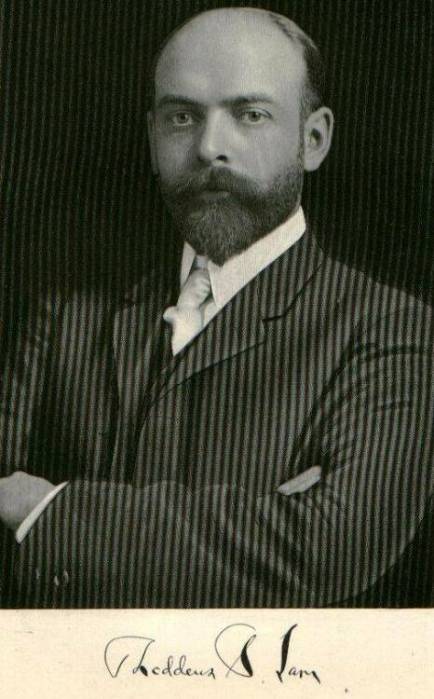
The very next month following Crumb, Thaddeus and several others
organized the Montana Independent Telephone Company (MITC). Authorized capitalization was $1,500,000 in
6% bonds and common stock of the same amount; papers of incorporation were
filed May 12, 1906. The city council
took only two weeks to approve its franchise.
Twenty Montana business leaders immediately subscribed to the securities
at $5,000 each. Even F. Augustus
Heintze, one of the copper kings, was interested, although the strength of his
finances was in sharp decline.
(Sources: 8, 9, 12A, 12B, 12C, 26) (Link to Footnote C)
C1
The initial investors and directorate of MITC included T.S. Lane,
who was in charge of construction, a cadre of well-known Butte bank presidents,
Con Kelley of the Anaconda Company, P.B. Moss of the Billings First National
Bank, W.G. Conrad and Thomas Couch, Jr. from Great Falls, Harry Gallwey of the
Parrot Mining Company, and Elmer Jones of the Utah Independent Telephone
Company. Soon to be included were John
MacGinniss, a Butte banker and Heintze confidant who had married into the
family of copper king W.A. Clark’s brother, and former State Auditor and
railroad capitalist, A.B. Cook of Helena.
These last two men with Lane would form the nucleus triumvirate of
future dealings, some of which would become top-drawer machinations of the era. (Sources: 13B, 14A, 14B, 14C)
Sophisticated
Strategic Planning I
Part and parcel of MITC’s formation was another company organized
by Lane and a few directors one month later on June 16, 1906: the Inter-Mountain Construction
Company. Its formation was a
significant lynchpin as Lane planned construction activities in Butte, as well
as a wider expansion into other Montana communities. A separate construction company could provide flexibility to
segregate messy construction liabilities and activities away from the balance
sheet of the telephone company. Raising
money from small subscription investors in which early generation investors
could be (and often were) paid by subsequent generation investors (a ponzi
scheme), if done by the construction company, ostensibly would not tarnish the
telephone company’s reputation.
Completed facilities could be transferred to the telephone company, away
from construction company creditors.
Contract manipulation between the telephone company and construction
company would allow very substantial write ups in the values of telephone
company securities held by the construction company and its owners (and
corresponding plant value write ups on the telephone company balance sheet), as
well as the ability to extract several levels of profit margins from ongoing
contracts with the telephone company. If complexities arose, transfers of
funds, financing and other details back and forth between the telephone company
and the construction company easily could be accomplished with little or no
scrutiny. In short, telephone company
financials could be hyped as “conservative” and profitable, while construction
company financials and their potentially large profits would be hidden from
public view. Two more construction companies eventually would be formed: The
Western Engineering Company for Helena exchange construction and the Montana
Engineering Company for Great Falls exchange construction. (Sources: 16A, 16B,
16C, 16D, 28) (Link to Footnote
D) D1
A letter segment, Lane to Cook, is worthy of a thoughtful reading
because it demonstrates in Mr. Lane’s own words the financial finesse he coaxed
and cajoled between construction and telephone company financials. The telephone company name has been changed
to ‘X’ to assist in an easier to grasp understanding of where the pea is under
the shells: “In order that you,
MacGinniss and myself show six payments up to date, I can think of no other way
to arrange it except on the books of the Telephone Co. ‘X’ to credit each of us
with our payments and charge the Inter Mountain Construction. Co. The Inter Mountain Construction Co. will
show a debit against each of us for this amount, which must, in some way, be
repaid. It is not quite clear in my
mind just how to handle this, but perhaps the best way is to have the Telephone
Co. ‘X’ advance money to the Inter Mountain Construction Co., and the
Construction Company loan it to Cook, MacGinniss and Lane, and Cook, MacGinniss
and Lane pay it into ‘X’.” These
complex financial arrangements were classic early 20th century financial
obfuscation, complimented by the period’s lax accounting standards. The astute Mr. Lane mastered these practices
as a slick modus operandi --- lock, stock and smoking barrel. (Source: 17)
This kind of shenanigry may have comprised the building blocks of
titans in the Age of Empire, but the Populist and Progressive movements rooted within
average working folk in the early 20th century hotly resisted them. This especially was true in places like
Butte. Trust busting and threats of
public ownership of certain private corporations were in vogue, and gaining
traction. Muckraking, such as Paul
Latzke’s “A Fight With An Octopus” published in 1906, fueled a populist public
angst, in this instance against the competitor Lane would again face, the Bell
conglomerate. (Source: 9)
Latzke’s introductory summary at Chapter One heralds the sentiment: “The story of the Bell companies rise to
power that was second only to that of the Standard Oil Company—The betrayal of
friends and associates, the sacrifice of great national characters and the
desperate purpose of a fight that was carried straight into the White House—The
waning of the power of the trust and the triumph of the people.” The newly transplanted Mr. Lane would need
to exercise caution, and employ his personal charisma, to avoid being lumped in
with Bell as an abuser of the public trust in the rough and tumble Montana mining
camp.
It was against this backdrop that MITC planned local exchange
networks in Butte, Anaconda, Helena, Great Falls, Missoula and Dillon, along
with the purchase of existing local exchange networks, such as those in
Bozeman, Livingston, Billings and other small communities. Six of these in the
largest Montana communities (comprising most of the populace to be served)
would house Almon Strowger’s AEC automatic switches and use dial
telephones. The company over-optimistically
predicted a customer base of 10,000 within a year following initial Butte area
construction. (Sources: 15, 64A, 66, 67)
MITC’s plans for a
complimentary instate long distance toll system were in addition to the
local exchanges. The toll system would
interconnect the large communities just mentioned, and in so doing would string
together a multitude of small town local exchanges with manual switchboards and
up-to-date central battery systems, sometimes in leased buildings. With his
skills of persuasion and hearty embrace of the Independent company movement, Mr.Lane
also would be able to purchase small, relatively rural companies with little
more than securities of his own companies for payment. He thereby could create a synergistic
Independent toll system, an avenue perhaps not as palatable for Bell, given its
slow capital deployment in rural Montana. (Source: Stock certificate, 13B, 69,
65, 67)
Another long distance toll system, that being a rather grandiose multi-state
long distance toll system, were explained in a mid-1906 issue of the American Telephone
Journal: MITC would partner with the
Utah Independent Telephone Company, joining at Pocatello, Idaho. To the west, it would connect at Missoula
with the Home Telephone Company of Spokane.
Director Jones from Salt Lake City had arranged for the use of Western
Union telegraph poles, as well as various railroad rights-of-way allowing
eventual long distance toll all the way to San Francisco. (Source: 15)
A Constitutional
Wrinkle
A year later, these long distance toll plans could have been
modified pursuant to a July 1907 decision by Federal Judge William Hunt of
Helena, who upheld Montana’s unique constitutional provision requiring
telephone interconnection. The
potential importance of this provision and Hunt’s decision can’t be overstated. The constitution specified that any
telephone company had the right to connect its lines with those of any other
telephone company. The Montana
legislature had enacted provisions for this constitutional specification nearly
coincident in time with the expiration of the original Bell system
patents. (Sources: 1889 Constitution
Sec.14 Art.15; 1895 Legislative Code Section 4401; 155 Fed 207)
Recall from the sidebar discussion earlier regarding Bell’s
lynchpin long distance toll strategy: after the expiration of its patents, Bell
planned to isolate Independent company local exchanges from important big city
Bell local exchanges by refusing to let the Independents interconnect via ATT
long distance toll lines. In Billings
Mutual Telephone Company v. Rocky Mountain Bell Telephone Company, Judge Hunt
held that physical interconnection and right of use was compelled by
statute and the state constitution, and that damages were to be assessed as
provided under the Code of Civil Procedure if a “compensation” agreement for interconnection
couldn’t be reached. (Source: 16)
In 1907, only Montana, South Dakota and Texas had enacted specific
statutory language regarding interconnection, and of these three, only in
Montana was the statutory language buttressed by its constitution and an
affirmative decision in a Federal Court.
T.S. Lane could have opted to enter the Montana market with his advanced
local exchange automatic switching and dial telephones, and then used RMBC’s
long distance toll lines to interconnect his local exchanges. Even RMBC local exchanges could have been required
to interconnect with Lane exchanges.
Many Independent companies in other states agitated for this approach in
years to come, but they lacked the legal underpinnings available in Montana. (Pictured below is a physical
interconnection cartoon of the day, with one version of the Bell octopus.) (Source: 17)

Lane demurred from this approach; RMBC’s aging technology and his
plans to build his own synergistic toll system mentioned above may have been a
factor. More importantly though, the
shrewd Mr. Lane knew this critical issue with nationwide ramifications
undoubtedly would be bound up in court by Bell. Sure enough, after three years of further court proceedings,
Judge Hunt finally was able to appoint O.T. Crane, N.B. Holter and W.C.
Bruskett of Helena to determine the Billings “compensation” question for
interconnection. The 1907 victory for
Independent companies in Montana nearly had been laid to waste by RMBC’s legal
tactics. We shall see, though, that the
issue retained a spark of life. (Source: 18)
Other Planning
Considerations
Evidence about the
competitor MITC would challenge can easily be gleaned from the May 1906 RMBC
telephone directory. It was a mere 6 ¼”
x 9 ¼” x 3/8” thick, a minimally sized book considering it included all Montana
customers in twenty-five local exchanges, and all customers in six Idaho
exchanges. Several instructions in the
book demonstrated RMBC’s spartan, nearly brusk approach to instructing the
public on how to use its operator-assisted technology:
--“Subscribers are requested to call only by number, and to
strictly avoid loud and boisterous conversation.” The first part of this instruction required customers to use the
telephone book, rather than asking operators to retrieve numbers. The second part dictated behavior. This instruction would be superfluous for
most of the customers served by MITC, with it preponderance of automatic
switching and dial telephones.
--“Subscribers are not permitted to allow non-subscribers to
use their telephones, such being in violation of their written contracts.” and
“Profane language over the wires is strictly prohibited. The Company reserves the right to remove the
instrument for violation of this rule.”
RMBC operators in the relatively small communities served in Montana
would have been able to monitor these behaviors as a kind of “big brother”,
while MITC’s cutting edge equipment
would protect most of its customers against such intrusion.
--“When it is desired to have a non-subscriber called into one of
our public offices at a distant place, a messenger will be sent for him, during
business hours, at the expense of the party ordering the service.” The telephone directory provides no further
guidance on the cost of the service, but “Messenger Boys” was advertised in at
least nine locations in just the Butte section of the thin directory. This service was convincing evidence of a
less-than-optimally served telecommunications market in Montana: it was
tantamount to delivery of a telegram.
MITC competition would begin remediating this situation with more
technologically advanced and less expensive service, thereby alleviating the
need to use “Messenger Boys”. (Sources:
104 and May, 1906 RMBC Directory)
(Pictured below is the cover of the May 1906 RMBC directory.)
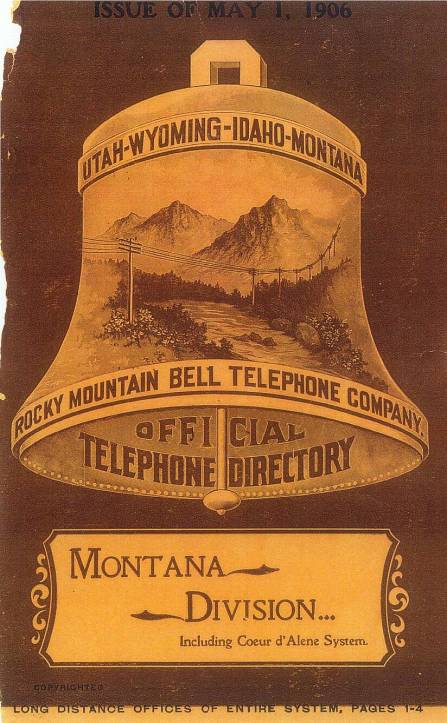
Another competitive consideration was solved at the 1907
Legislative session, that being the unwillingness of railroad, express and
telegraph corporations to allow installation of Independent company telephones
in their stations. These entities
predictably didn’t care to facilitate competition of any kind. However, the issue was of vital importance
to the Montana Independent Telephone Company (MITC) because significant numbers
of local businesses absolutely needed telephonic communications with these
principle transportation and freight operations. Accordingly, Lane and his MITC supporters pushed House Bill 291
to successful passage. Its language
required all public railroad, express and telegraph stations and offices to
install or allow to be installed in every city and town served, a telephone
from each telephone exchange operating in the locality. Furthermore, it required promptness in
answering incoming telephone calls, as well as “correct replies to be made to
all reasonable and proper inquiries” made during business hours. Failure to comply was a misdemeanor. (Source: 80)
Labor unrest among Bell linemen and operator corps significantly benefited
the fledgling MITC in the midst of its Butte exchange construction when two
short strikes were waged, followed by a ten-month strike starting June 8,
1907. The strike would reduce Rocky
Mountain Bell Company’s (RMBC’s) customer numbers. As well, the effects of this strike spread to the Montana
Federation of Labor and Helena Trades and Labor Assembly, which ordered strikes
at businesses where Bell telephones were installed. In December, a mob of 300-500 dangerously drove six non-union
Bell employees from Butte, despite a restraining order issued by Judge
Hunt. The next February, Presidential
pardons were denied to Lenihan, who was past president of the Electrical
Worker’s Union of Anaconda, Plunkett, Shannon, Cutts and Edwards; each was
sentenced to 4 months prison time for violating Hunt’s order. (Sources: 19A, 19B,
19C, 19D, 77) (Link to Footnote
E) E1
Another city in which RMBC found discontent was Great Falls, the
home of MITC investors W.G. Conrad and Thomas Couch, Jr. In the spring, 1907 a large meeting of
citizens was held to adopt resolutions condemning Bell’s poor service, unfair
operator wages and high rates. One
account suggested that citizens unilaterally remove Bell company telephones if
a resolution solving their concerns wasn’t forthcoming. Red Lodge, Billings Livingston, Bozeman and
Lewistown also were hotbeds of labor discontent targeted at RMBC. (Source: 20)
Conjecture may lead one to assume that directors were fomenting
citizen discontentment in Butte and Great Falls. However, the business case alone was convincing since it rested
upon the precepts that the RMBC facilities and business model in Montana were
antiquated in a field evolving quickly with newer technology and lower
rates. In fact, RMBC average rates in
Montana were 20% higher than those in every other RMBC state---Idaho, Utah,
Wyoming and Eastern Oregon---with Butte and Helena having the highest rates.
The high rates persisted even though it was not unusual for used equipment to
be recycled into Montana from other RMBC states. As is many times the case, Montana would not be a recipient of
better technology and rates--that is, unless competition forced the issue. Beyond technology and lower rates was
another very basic issue: many Montanans simply didn’t have access to telephone
service at all, especially when compared with the more abundant access enjoyed
by Americans in other areas, even in states close to Montana. (Source: 105,
111)
Statistics relate the dearth of telephone service in Montana in
1907. Nationally, 1 of every 14.1
Americans had a telephone. The
comparable number in North Dakota was 1 in 14.2; even in mountainous Idaho the
number was 1 in 16.0. Montana lagged
36% behind the National number at 1 in 19.2. (Several Southern states recovering from the Civil War trailed
Montana.) The year 1907 would prove to
be the pinnacle year for Independents in America with about 50% of all
telephones being Independent. Although
the small farmer Independents in Montana had done an acceptable job, the truth
of the matter was neither Bell nor the Independents had deployed sufficient
capital: Montanans were underserved in
the new information age. Thaddeus Lane
was about to change this dynamic in 1907.
Within five years when 1 in 10.9 Americans would have a
telephone, the number in Montana would be 1 in 11.3, a difference of less
than 4% from the National number.
Much of this rapid positive enhancement in telephone service access and
more advanced telephony in Montana was attributable to Mr. Lane and his
competitive Independent companies.
These changes within the span of just five years aptly would be
described with superlatives: the work of “genius”. (Sources: 5, 23, 70)
Independent’s Day,
Butte
When on September 16, 1907 the Montana Independent Telephone
Company made operational its beautiful new three story exchange building at 124
West Granite Street in Butte, its rates and the RMBC rates were as follows per
year: For one party residential—MITC
$36, RMBC $42; for one party business—MITC $72, RMBC $80; and, for two party
business—MITC $54, RMBC $72.
Approximate numbers of telephones were:
MITC 225, RMBC 2,200. Within
three years, these numbers would be:
MITC 4,750 (an increase of over 2,100%), RMBC 1,500 (a decrease of 40%).
(Pictured below is an early MITC ad from just before September 16.) (Sources: 12A, 12C, 104, 109)
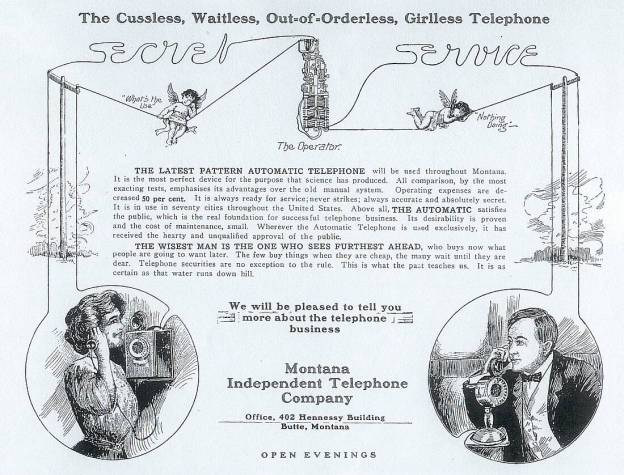
The exchange featured equipment supplied by the Automatic Electric
Company (AEC) of Chicago, the leading and enduring Strowger automatic switch
provider, which also financed Lane to some degree. The AEC advertised its facilities, if installed in a city of
100,000 people, would save 1/3, or about $67,000, in construction costs vs. a
manual cord board system, and also would save 40% in operating costs each year,
due in part to elimination of most operators. (Sources: 25A, 25B, Network
Nation p. 356)
Other features of the exchange were the duplicity of important
equipment, alarms and light sensors for trouble alerts and 100,000 feet of
underground conduits for main circuits.
(A somewhat dilatory issue affecting RMBC customer additions was its
more extensive use of overhead wire on poles; these were unsightly and placed
constraints on new customer numbers.)
Manhole #1 in the basement of the MITC exchange was 6’ x 7’ with
twenty-eight ducts each able to handle 400 customers. MITC private branch exchanges, or PBX’s, were installed at the
Anaconda Mining Company and Hennessy Mercantile Company, with other large businesses
in the order queue for their own PBX systems.
(Source: 12A) (Link to Footnote F) F1
The standard MITC dial telephone was nickel plated, with black and oak models available; their deployment required public education. The following instruction was featured in an advertisement announcing the opening of a typical Lane automatic exchange: “The instruments have the general appearance of the old style manual telephone, with the exception that the small dial is installed in the base of the instrument. The subscriber connects with the telephone desired with three or four pulls of the dial, the ringing signal being given automatically without effort on the part of the subscriber.” The ad continued by describing how to dial the telephone number “650”. Independent company publicity included open house showings at new exchange buildings so as to showcase the inner workings of the automatic equipment. (Pictured below are two models of AEC dial telephones from the period.) (Source: “The Treasure State”, December 18, 1909, Montana Historical Society)
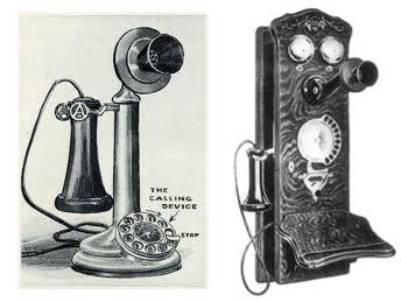
Butte’s population of about 86,000 and its substantial industrial
and business base afforded MITC an excellent chance to sell the community on
the advantages of modern, automatic dial telephone service. It did so by offering a free service trail
for a month or two to every Bell subscriber who expressed interest in MITC
service. Nearly 900 telephones were at
customer locations on the day the exchange opened, with 225 connected. Some customers had dual service with RMBC
and MITC. Nearly 3,000 telephones had
been placed within six months, a number nearly 40% higher than Bell’s installed
base after doing business for twenty-five years in Butte. Success seemed to be
assured. (Sources: 12A, 12B, 21, 22)
(Link to Footnote G) G1
The new exchange launched Butte into the next chapter of the
budding information age, financed largely if not completely with “Montana
capital”. This included more than 400
Montana investors statewide “representing nearly every large interest in the
state, as well as every trade and profession”.
(By comparison, there were just 24 RMBC stockholders in its Montana
service territory in late 1906.) Investing
in a local Independent company apparently appealed to a wide swath of Montanans. Within another 2 ½ years the number would be
nearly 2,000. (Sources: 9, 12A) (Link
to Footnote H) H1
Independents’
Days, Montana
As Lane built out his Independent system in Montana and
westward over the next few years, accounts suggest that he was
exceptionally capable in his ability to build a shared vision among investors,
customers and employees. Recall while
in New York he had parlayed his telephone activities to encompass forty-two exchanges
in just a few years. These same but
even more finely honed skills in Montana were heartily appreciated. For example, the Helena based and
unaffiliated “The Treasure State” magazine would extol upon his “invaluable
faculty of radiating local confidence, inspiriting dejected enterprise,
restoring self-confidence in others and urging forward the rapid economic
success of all his undertakings.”
Visionaries, technologists and promoters in Lane’s day and forward,
including those operating within the present day of information age technology,
may understandably relate to Lane’s skills as he ensured through his
sophisticated maneuverings that the most up-to-date technology at reasonable
prices would be available to customers.
(Source: 5)
Without going too far afield, it is important here to consider the
cultural shift occurring at this time in Montana. Early 20th century Montana witnessed a spirit akin to that of
manifest destiny; its optimism spurred the development of what had been
pioneered just a few years preceding.
Good and growing rail transport was prospering. Large corporate mining and timber
development were in full swing. The
small farm homestead boom with its irrigation projects and the damming of the
mighty Missouri waterway to provide long distance electricity were ready to
launch. Recollections of the bison,
open range and original pioneers were etched into the Montana psyche as
remnants from the tough frontier, but the 20th century was shoving aside these
recollections with its new opportunities of airplane experimentation, mass
automobile production, longer distance telecommunications, moving pictures, the
phonograph, deForest’s radio broadcasts and even Einstein’s theoretical physics
of relativity. Seemingly frivolous
inventions of the period would contribute to convenience and the soon-to-come
age of consumerism: the coat hanger, crayons, Popsicle, paper towels,
cellophane, life savers, the zipper, the shopping bag and a board game that
later would be named Monopoly. Thaddeus Lane, born of the generation
following the Civil War, had watched the physical westward line of the frontier
disappear. But a new and rapidly
expanding technological frontier arising as the next phoenix was ready for the
entrepreneurial taking with few restrictions, if one desired to pull at its
brass ring. Thaddeus Lane would give it
a good hard pull indeed, helping Montanans to spread their technological wings
during this period and catch a glimpse, albeit partially fleeting, of the
future.
The “good hard pull” was manifested in the map of the Lane system
of telephone companies published by Telephone Securities Weekly a couple of
years after the Butte exchange opened showed an extensive system extending
north from Butte to Helena and Great Falls, thence north to Conrad, thence from
Great Falls east and south to Lewistown, Roundup, Billings and Red Lodge, thence
west from Billings through Livingston and Bozeman. From Butte west it shows Anaconda, Deer Lodge, Missoula, thence
south to Hamilton; from Missoula thence north and west to Coeur d’Alene,
Spokane, Sand Point and thence back east to Thompson Falls; from Spokane thence
south and west as far as Pendleton, Or and Lewiston, Id. A total of forty-nine local exchanges and
many toll offices were depicted.
(Pictures below are: a 1907 Montana
system planning map; the Helena exchange subsequently modified with a second
story; and, a circa 1911 Helena exchange telephone directory.) (Source: 9) (Read about technical and other
features of the Lane system at this link: Lane
Automatic System Sidebar) LSS
|
|
|
Local exchange and combination local/toll companies of which Lane
was president by this time included separate Automatic Companies in Helena and
Great Falls, the Billings Mutual Telephone Company, the MITC at Butte,
Anaconda, Missoula and Hamilton, the State Telephone and Telegraph Company at
Bozeman and Livingston, the Interstate Telephone Company Limited at Coeur
d’Alene, Sandpoint and Panhandle, the Idaho Independent Telephone Company at
Pocatello, and the Home Telephone and Telegraph Company at Spokane. Finally, there is one more Lane company to
seriously consider, it being of supreme importance in this unraveling
tale: A holding company called the
Interstate Consolidated Telephone Company (ICTC). (Source: 9)
The genesis of ICTC’s formation as an overarching holding
company that would own all of the other companies listed above was detailed in
five carefully written pages a few years earlier on December 13, 1908, Lane to
A.B. Cook, as follows: William Mead, a
Los Angeles capitalist and high flyer, was pursuing Lane to invest heavily in
the Home Telephone and Telegraph Company of Spokane, an Independent
company. (Recall Lane had considered it
in conjunction with his westward reaching long distance toll system plans.) It
had incorporated in 1906 and contracted with Empire Construction Company of Los
Angeles to build an exchange and underground lines; construction had begun by
December 1906. In September 1907 the
journal Telephony issued an exposé alleging the Kellogg Company, whose
switching equipment had been used by Empire (and others), was controlled by the
Bell system, and that this equipment would be used to undermine completed
Independent company facilities. Mead’s
National Securities Company of Los Angeles was involved in financing Spokane,
with nearly $350,000 spent for an unfinished exchange on Howard Street and
200,000 feet of underground conduit. Mead wanted Lane to invest and finish the
languishing construction. Lane’s letter
to Cook listed a Byzantine arrangement of financing, alliances,
responsibilities and optimistic completion dates. It is his first known salvo initiating the Spokane affair. Eventually it would be Lane’s nadir and
would lead to the undoing of his progressive Montana Independent company
telephone network.
Following up the letter to
Cook, Lane persisted with another even more detailed letter to another director
in May 1909, Lane to John MacGinniss.
In it he specified how ICTC would acquire the stock of all the other
Lane companies, how the corporate structure would be patterned after the Bell
octopus model by separating long distance toll facilities from local exchange
companies so as to realize higher returns on investment, how centralized
financing could be accomplished by ICTC and very importantly, how this
financing could be designed to make better use of a favorite Lane financing
device, that being watered bonus common stock used to entice potential
preferred stock and bond holders, salesmen and underwriters. (Sources: 13A, 31D)
Most importantly of all in the letter, Lane clearly declared his
over-riding goal, a seemingly incongruous goal given his theretofore
rock-solid reputation in Independent company telephony. He was proposing ICTC as a vehicle to
facilitate the eventual sale of all the Lane-centric properties to Bell
because of “unusual profit possibilities”.
He specified that the holding company would have “a property and
territory which the Bell Company must eventually acquire, unless it
wishes to entirely abandon Montana, Idaho and Eastern Washington, which is not
at all probable.” He surmised that the
older RMBC facilities and operations would be wound down so that Bell could
“endeavor to hold the field by acquiring the various Independent properties in
the Rocky Mountain territory, which have taken the business and have the
advantage of superior construction, equipment and public sentiment.” He continued: “In this connection, the fact that we will have an absolute
monopoly of automatic telephone equipment in our territory, should not be
overlooked, as it is one of our strong assets.” He punctuated the letter’s end by explaining plans for telegraph
service on his telephone lines, as well as his pressing desire to enter
the Spokane market. (Source: 31D)
The ICTC was breathed to life on October 21, 1909 as the holding
company for all of the other Lane companies; its authorized capitalization was
$5,000,000. Directors within a few
months after incorporation included:
Lane; T.I Greenough, capitalist,
Missoula; A.B. Cook and John MacGinniss, Patrick Wall, attorney, Butte; and, William Mead, National Securities
Company of Los Angeles. Others were
interested as well, including John F. Davies, a Butte attorney, who would
become Secretary. (Pictured below is
an ICTC stock certificate; the owner was Corporation Securities and Investment
Company.) (Sources: 26, 26A, 112)
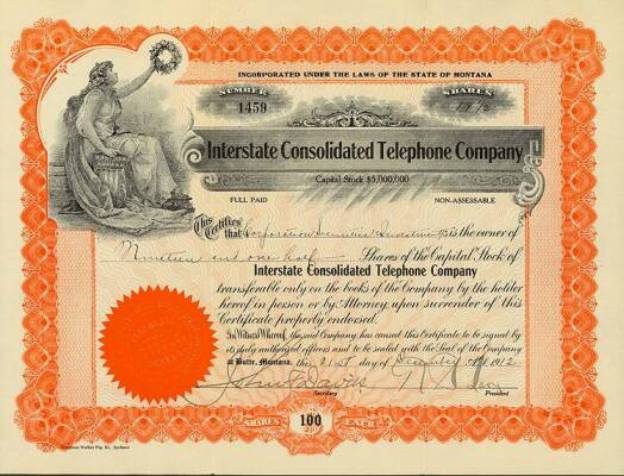
Formation of the ICTC holding company marked a bright line
transition in Lane’s strategy and the Independent company movement in
Montana. He realized that a single
point of ownership would be highly advantageous if the telephone operations
eventually were to be sold, which was his new goal. Balanced against holding company goals and a corporate headquarters
relocated to Spokane, was the public relations challenge of at least appearing
to be a local Independent operation in the somewhat profitable Montana communities
that gave him his start in the West.
They had, after all, heartily embraced the idea of goodwill, financial
support and local ownership.
Once again, Latzke’s “Fight With An Octopus” was relevant. A chapter familiar to Lane and Montanans,
“The Fate of a Traitor”, discussed Independent company sales to the Bell
octopus: “It is probably difficult for
the ordinary businessman to understand why a person should not have the right,
unchallenged, to sell his property as he pleases, even if that property
consists of a majority of the stock of an Independent telephone company, which
can be turned over to the Bell at a fancy figure. But to the men in this
movement the moral wrong of such a transaction is as plain as day; they would
as soon concede that Benedict Arnold had a right to sell out to the
British. Nor does their argument lack
force or logic. They insist that, when
a man or a body of men organizes an Independent telephone company it is not
only the money paid in for apparatus and equipment that is capitalized, but the
goodwill, support, and friendship of their neighbors as well.”
This populist/progressive sentiment especially was keen in Butte
where Lane sorely needed to maintain local confidence; it above all was his
foundation. A good example of his endeavors
in this direction was the message to customers and investors in March 1910 when
he addressed in writing the “vicious” tactics of Bell, spoke of MITC’s good
earnings, and rose to the bully pulpit in praising the local ownership of the Montana
Independent Telephone Company (MITC).
(Source: 27)
Spokane Becomes
The Primary Focus
Irregardless, at least a few minority stockholders in Butte,
perhaps under Rocky Mountain Bell Company (RMBC) guidance, were becoming
suspicious; they provided a detailed, sophisticated written notice of
complaints regarding Lane’s modus operandi and called for a meeting of
stockholders in the courtroom of a local District Court Judge. As Butte public opinion clouds were building
in 1910, Lane moved his residence from Butte to Spokane. (Source: 28)
Just after his move in the fiscal year ended in April 1911,
Montana operations appeared to be performing acceptably: MITC gross revenues were $218,998.45,
expenses were $178,642.61, which
included bond interest but not plant depreciation, and net earnings were
$40,355.84. MITC telephone numbers had increased
during the year by 2,095 to 7,278 as follows: Butte 4,880; Anaconda 534;
Missoula 1,102; Three Forks 95; Deer Lodge 243; Stevensville 107; Basin 22;
Logan 27; Drummond 48; Boulder 68; and, the brand new exchange at Hamilton 152. Service innovation included a wake up call
service, at least in Butte. If any of
the 400 patrons subscribing to it did not answer within ten minutes of the time
they designated to receive their call, a messenger was dispatched. Revolving work shifts at the mines may explain
the popularity of this innovative-for-the-times service. (Sources: 29, 62A)
Telephone statistics for other Lane properties, such as the
Helena, Great Falls or Billings companies would be shown in their own
respective company reports. Suffice it
to say, Independent telephone numbers in Butte were more than five times those
of RMBC, Great Falls was three to one and Helena was equal. The Montana local exchange and long
distance toll system operated in abstentia of Spokane likely would have
prospered, especially if appropriate RMBC interconnection could be utilized, as
provided by Montana law. Spokane,
however, would be a horse of a different color. (Sources: 30, 83, comparison of telephone company directories for
Helena numbers)
After the Howard street exchange became operational in Spokane,
significant sums (see next paragraph) would need to be expended during later
1910, 1911 and into 1912 to make the Spokane operations viably
competitive. Most immediately pressing
was the need to actually start providing service to at least 4,000 customers before
any revenues at all could be collected, per the franchise. Lane predicted 15,000 SHTC telephones, then
30,000; but only 3,000 had been placed as of April 1911; this meant no
meaningful revenue, and a plethora of expenses accumulating since October
1909. To build-out the operational
capabilities of the system, he constructed a large main office exchange, the
Roosevelt Exchange (former President Theodore Roosevelt ceremonially assisted
in making operational the Roosevelt automatic exchange in April 1911, the
largest in the ICTC system with a 100,000 line potential), another exchange at
Hillyard, as well as several smaller exchanges/sub-exchanges. Also he rebuilt some of the facilities
poorly constructed by the Empire Construction Company. (The Roosevelt exchange building is pictured
below.) (Sources: 30, 31A, 31B, 31C,
31D, 31E)
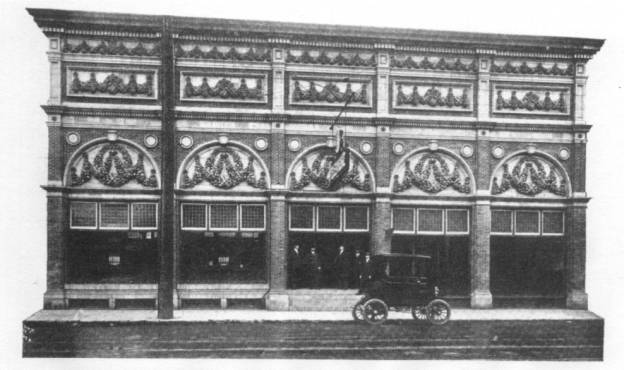
To provide long distance toll service between the Interstate
Consolidated Telephone Company (ICTC) systems in Montana and those to the west,
the company was extending its toll infrastructure through the “wilderness”
terrain west of Missoula through Mullan, Idaho. Not even the Bell system had successfully traversed this
terrain. (The first major Bell long
distance line through this area would wait until the mid 1920’s when the
Northern Transcontinental toll line was completed.) To the west, Spokane to Seattle, Lane had arranged to lease lines
from the Postal Telegraph Company, which was making a valiant attempt to form
alliances with Independent companies across America so as to combat the
ATT-Western Union combination. (ATT had
purchased a controlling interest in Western Union in 1909, a highly incendiary
decision long contemplated by Bell.)
The roughly $1,000,000 needed for the Spokane local exchange build out
and toll facilities east and west of Spokane, all within a 1¾ years timeframe,
would stretch ICTC financing needs beyond its capabilities. (Sources: 22, 31D, 32A, 32B, 32C)
Financial Stress
Lane found himself in a classic capital squeeze: Adequate and reasonably priced financing was
needed to build large facilities in a larger market in which demand was
increasing, but would remain muted until a viable build-out was completed. Layered on was a long-tenured, entrenched
and larger Bell company competitor and the financially debilitating
provision in the Spokane franchise requiring free service until 4,000 customers
were connected. (Source: 31B)
Adding uncertainty to ICTC
plans was the provision in its Spokane franchise allowing the city to purchase
ICTC facilities. Perception amongst
potential financiers of this possibility would have been palpable; voters in
Seattle passed by more than a 3 to 2 margin in November 1911 an initiative to
purchase “its” local Independent telephone company. (Great Falls citizens also were monitoring the Seattle
initiative.) One important factor
working to ICTC’s advantage, if it could find financing over the ensuing couple
of years, was the expiration in 1914 of the Bell company’s Spokane
franchise. (Sources: 63A, 63B, 82)
Coincident with Lane’s telephone activities in Spokane was another
newly undertaken endeavor with the potential to backstop the stressed financial
needs of the telephone empire. Involved
in it with Lane were familiar cronies MacGinniss, Cook and others; Lane was
president/vice-president, while Cook/MacGinniss were directors. Together they had had become officers/directors
on the bully pulpit for a fire insurance company in Spokane, the Western Empire
Insurance Company, and a newly formed life insurance company in Montana, the
National Life Insurance Company. The
companies appeared to be financially solid per their year-end 1911 annual
reports to shareholders and the Washington insurance regulator. (Sources: 33A, 33B)
A June 6, 1911 letter, Lane to Cook, exemplifies the close
relationship between the telephone companies and the insurance companies as it
memorializes Cook’s trade of $18,000 of telephone company bonds of the Helena
Automatic, the Idaho Independent and the State Telephone, for 216 shares of Western
Empire Insurance Company stock.
MacGinniss made exactly the same trade per an August 4th
letter. The Cook/MacGinniss telephone
company bonds were traded at par value, while the insurance company
stock value was discounted seventeen percent. What occurred in the context of the significant financial stress
and perhaps receivership concerns at the Lane telephone companies was: at the very least, unethical individual risk
mitigation by insiders; or, even more egregious if the insurance company shares
were quickly sold on the open market, a subterfuge to transfer $30,000. into
struggling telephone company financial needs.
Policy owners and small investors sold on the value of local insurance
company patronization would have been clueless to these tactics affecting the
stability of their insurance company investments and products. (Sources: 33, 33C)
As the 1911 calendar ticked away, Lane juggled the significant
telephone financing needs from many angles, including offering his personal
assets as collateral. Two money sources
to which ICTC became more and more indebted were Willaim Mead, and the Automtic
Electric Company (AEC). Smaller
creditors, like The Exchange National Bank of Spokane, were tightening the
noose on co-signors of ICTC notes. The
bank’s August 31 letter to Cook demanded payment: “Please take notice that the note of $25,000 signed by the
Interstate Consolidated Telephone Company, dated March 11-11 and due July
11-11, with interest at eight per cent, is past due and unpaid. Repeated demands upon the Telephone Company
have failed to bring results. We
therefore look to you for the payment of the same.” (Sources: 25B, 34A, 34B, 34C)
A Giant Awakens
Contra to Lane’s troubles, the Bell system was firming up
its strategies during the last half of 1911 so as to advance its telephone
industry coup-de-grace combination of ATT and Western Union. In August it offered the first large
underwriting for the Mountain States Telephone and Telegraph company (MSTT),
which combined the assets of the following companies: Colorado Telephone
(Colorado, New Mexico), Rocky Mountain Bell Telephone (Utah, Idaho, Montana,
Wyoming) and Tri-State Telephone and Telegraph (Arizona, southern New Mexico,
El Paso County Texas). Pacific states’
operations remained with Pacific Telephone and Telegraph. The prospectus made particular note of MSTT
financial strength. (Source: 35A)
Near years end, Lane was attempting to arrange a hail-mary sale of
securities in the east to cover unpaid bills, and most importantly, to pay bond
interest expense coming due in November.
Unpaid bond obligations could force ICTC into receivership. Coincident with Lane’s financing trip to the
east coast in late 1911 was a pronouncement made in the Spokane Chronicle by
ATT president Theodore Vail that “as soon as the people demand it, the Bell
company will purchase the various competing telephone systems now operating in
the northwest.” (Theodore Vail is
pictured below.) (Sources: 36A, 36B)
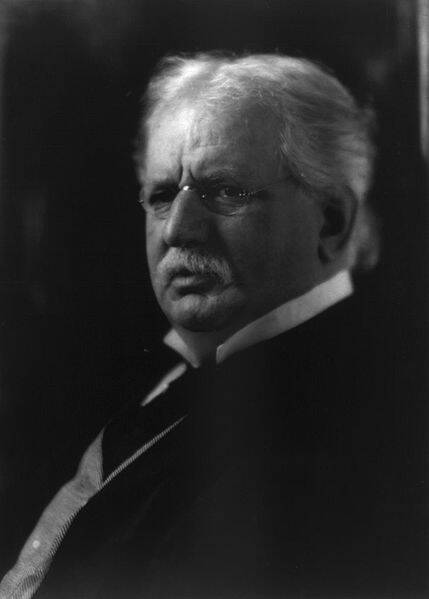
Vail’s most conspicuous
previous attempt to buy or merge with the Independents came a year earlier when
a committee of seven leading Independent company representatives were appointed
by the Independent Telephone Association at a Chicago meeting. The seven
independent representatives, who met with Vail and a representative of ATT
owner J.P. Morgan (J.P. Morgan had acquired a controlling interest in ATT in
1907 and reinstalled a favorite son, that being Theodore Vail, who had left
Bell employment a couple of decades earlier), were treated to Vail at his
finest as he specified “the public had profited up to that time by destructive
competition, but that once the merger was formed, the company was going to make
the public pay for it.” Vail proposed a
$1.3 billion ($31.8 billion in 2011 dollars) merger at the meeting to take
place over several years with multitudes of Independent companies to be merged
and acquired. The Chicago meeting ended
without result, but the seed and strategy had been launched. (Sources: 37A, 37B, Network Nation pp. 312,
346-47, www.measuringworth.com)
Lane did acquire financing for the Interstate Consolidated
Telephone Company (ICTC) in the east from a German investment bank MacGinniss
had used when arranging Heintze financing, that being Hallgarten. The financing, at fire sale terms, procured
$150,000 by giving Hallgarten $190,000 in MITC bonds and the same amount of its
common stock as a bonus. It presaged
what could become a death knell scenario, using Montana operations as
collateral to shore-up Spokane.
Ironically while in the east, Lane also responded to Vail that the
Spokane Home Telephone company was not for sale. The response came through his talented publicity director, Byron
E. Cooney, who later would become a popular union-supported state legislator
from Butte. (His brother was future
Montana Governor Frank Cooney, 1933-35.)
(Sources: 38A, 38B, 84, 107)
Lane’s response, in his usual “generous and freehanded way”,
listed the alliance by Independent companies with the Postal Telegraph Company
to compete with Bell and the financial infusion by large international bankers
into securities of Independents in the northwest as factors that accounted “for Mr. Vail’s appearance at this time and
his frequently expressed desire to be permitted to operate without
competition.” In the response, he
raised the Butte operations as a model of modern automatic telephony. At the very time of his response, interests,
directly and indirectly controlled by Bell, would have been able to force ICTC
into receivership if the November 1911 bond interest had not been paid--and the
May 1912 payments soon would be due. In
effect then, Lane’s response largely was blustery publicity. (Sources: 34B, 36B, 38A, 39A)
The ICTC financial situation
was not unique in the Pacific Northwest.
Vail’s purchase offer was a broad one, and various companies appeared to
be financially stressed, or in receivership.
Such was the case with a there-to-for moderately successful toll company
in the Seattle area, The Northwestern Long Distance Telephone Company. Bell interests had engaged in several
strategic moves, leaving Northwestern high and dry of much of its business. Added to this were the usual Bell secretive
manipulations, some of which were exposed thusly in early 1912: A minority stockholder, who with William
Mead had been one of the original incorporators and directors of the National
Securities Company of Los Angeles, alleged that his former associate Mead,
through a title company he owned and which owned many of the bonds of
Northwestern, had conspired to force Northwestern into receivership so as to
acquire the property at a bargain price for Bell interests. This expose was the first public revelation
of William Mead’s real motives in deals he had been making in the northwest,
like that made with Lane in Spokane.
(Sources: 40A, 40B)
An End Game
Nearly coincident with Vail’s offer to purchase properties in the
Pacific Northwest was the formation in Great Falls of a committee to
investigate consolidation of Bell and Great Falls Automatic. (The city had supported a Bell competitor a
dozen years prior, The Dunlap Telephone Company, until Bell purchased it.) Questionnaires were sent to the two
companies under the signature of Chairman F.A. Fligman. Responses made it clear that neither party
wanted to sell to the other, but each would purchase the other under conditions
specified in its response. At a January
11, 1912 committee meeting attended by Lane and Bell representative H.P. Story,
intermarrying telephone competitors was discussed, with committee member
Herbert Strain reporting that Governor Norris, when querried by him, specified
that such a merger or purchase was illegal.
The ever-sharp Lane then introduced another “rather startling
proposition”: Great Falls Automatic
would agree physically to interconnect with Bell. The meeting ended without
result, but within 24 hours both the Great Falls Tribune and the committee
concurred with Lane’s offer, with the Tribune calling the proposal
“revolutionary”. The Tribune editorial
specified: “Inasmuch as the Automatic
company has a considerably larger number of subscribers in its Great Falls
exchange than the old company, its offer cannot be considered otherwise than
fair…”. Lane’s overture was tantamount
to a very public request, a dare if you will, to MSTT to interconnect per Judge
Hunt’s decision and the Montana constitution.
The Tribune Editorial referenced the Hunt decision. Lane’s bravado would serve him well, given
his tough financial situation; it had painted Bell into somewhat of a
corner. (Sources: 81, 89, 90, 91)
Within in few weeks,
MacGinniss and Lane traveled to Denver, on the one hand in a sort of grovel to
Vail’s financing and purchase overtures, and on the other hand, in a position
of some strength gained from what had happened in Great Falls. The trip was on the sly, although Cook
partially was privy. Although a sale
had been in the scheming since 1909, the cash strapped ICTC didn’t appear financially
to be very desirable in its nearly busted condition. Involved in the negotiations were the son of MSTT’s president and
corporate counsel Milton Smith. The
discussions resulted in a surreptitious contract whereby MSTT would purchase a
controlling interest in ICTC via a newly minted MSTT subsidiary---incorporated
on the same day as the purchase/sale agreement on February 3, 1912. The entity was named Corporation Securities
and Investment Company; its three directors were stenographers, two of them (M.
Stewart, President and H.C. Davidson, Secretary/Treasurer) in the employ of
MSTT. (Pictured below is a cartoon
showing a potential Bell payoff.)
(Sources: 38A, 39A, 41A, 108)
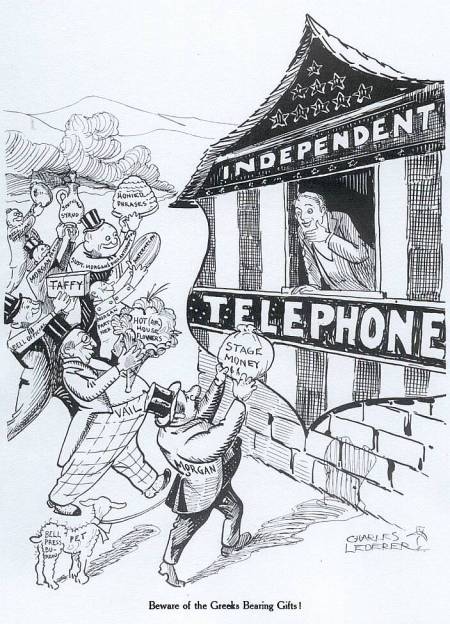
The illicit purchase was an arrogant abrogation of the clear intent
of Montana’s constitution, section 14, article 15: “No telegraph or telephone company shall consolidate with, or hold
a controlling interest in the stock or bonds of any other telegraph or
telephone company owning or having control of competing lines of
telegraph or telephone.” Montana’s
statute section 4402 included the exact same language, but no penalty clause.
(A penalty potentially of concern to Bell was possible revocation of its
Montana corporate charter.) The nexus between
Mountain States Telephone and Telegraph (MSTT) and each of Lane’s five Montana
companies competing with MSTT was hard to miss: MSTT clearly owned/controlled
the Corporation Securities Investment Company and the Interstate Consolidated
Telephone Company (ICTC) clearly owned/controlled Lane’s Montana
companies. MSTT’s formation of the narrowly
construed Corporation Securities and Investment Company was legal shenanigry
parading in its finest illegal attire. (Source: 83)
The controlling interest purchase of 17,555 shares was
accomplished very quickly at $82.85/share, a spectacular price unfathomable
under rational economic calculus, save that of a well-healed quasi monopolist
on a mission. The total amount paid to
Lane and MacGinniss was $1,454,400. The
shares largely would have been bonus stock in which these two men had invested
little or no money. Lane and MacGinniss
over the next six years helped to acquire the remaining securities of minority
interests of the Lane companies.
Questionable tactics sometimes were used, with a few sellers alleging in
legal actions that fraudulent tactics were used. The tactics were of some embarrassment to MSTT, since the purchase/sale
agreement clearly specified the average prices it would pay for the securities.
(Sources: 38A, 41A, 101)
At the time of the Lane/MacGinniss
sale to MSTT, ICTC’s book value was about $13/share with the stock trading on
the Spokane market at between $12-$20/share.
The price realized by Lane/MacGinniss from MSTT on subsequently acquired
shares is not known with certainty; in court proceedings spanning more than the
next decade, MacGinniss simply specified that they realized a variety of prices
for the shares. It safely can be stated
that many minority shares were purchased by the two men at between $20 and $50
share, knowing that they would sell the same to MSTT at $70/share per the
sales/purchase agreement. Be that as it
may be, in real dollars terms a century later in 2011, just the original profit
of $1,454,400 is equal to a CPI adjusted $34,800,000, and this profit was
realized in advance of income tax requirements enacted in 1913. Additionally, the bonds these men commandeered
previously at substantial discounts immediately would have been worth 100% of
face value, an event worth another fortune. (Sources: 38A, 41A, 101, 102,
www.measuringworth.com) (Link to Footnote I) I1
Lane danced on a tightrope in Spokane as word of his Denver trip
started leaking. A chief concern was
the franchise for the Spokane Home telephone company, which prohibited its sale
to a rival concern, i.e. Bell interests.
The January 13, 1913 Spokesman-Review reported Lane refuting rumors and
detrimental talk regarding Spokane Home, specifying these were circulated by a
few disgruntled stockholders and that the company was in excellent shape: “It is true the company owed a lot of money
some months ago, but the sale of the Great Falls plant wiped that out and the
company now is in a good condition. There
is absolutely nothing to the report that the Bell will buy out the Home company
in Spokane.” The article also
referred to the sale of the Helena plant.
His scheme was catching up with him, but in the end Lane would slip like
teflon through this web of deceit.
The Federal Government
Awakens Briefly; Montana's State Government Dozes
One office that should have been noticing changes in ownership of
Great Falls and Helena telephone companies was the ex officio Montana Public
Service Commission (PSC) of the Railroad Commission established in March 1913;
it was imbued by that Legislature with regulating all telephone provider rates
and services. Two years earlier,
Railroad Commissioner Edward E. Morely wrongly had predicted these duties would
be added by the 1911 Legislature:
“Personally, I favor the supervision and control by the commission of
the two enterprises just mentioned (telegraph and telephone), if for no other
reason than the fact that after the legislature has adjourned, in the
twenty-two months to follow, conditions may be such as to require our
services.” (Source: 42A)
Two months after its formation, the PSC sought an Attorney
General’s opinion regarding its powers to require consolidation with Bell of an
Independent company in the Hamilton area, known as the Bitter Root Valley
Telephone Company before MITC purchased it in the fall, 1909. Attorney General D.M. Kelly responded
immediately: The PSC couldn’t require
consolidation because Montana law comprehensively prohibited common ownership
or control of competing telephone companies.
He further opined that the companies could interconnect so that citizens
would be “relieved of the burden and cost of maintaining a double
service…”. If it weren’t already aware,
a coming national spectre soon would inform the PSC of the illicit MSTT/ICTC
combination affecting the Hamilton exchange.
Once informed, the Attorney General’s opinion could have assisted it in
setting the whole of the record straight, according to law. (Sources: 43A, 65) (Link to Footnote J) J1
Before newly elected
President Wilson was sworn into office early in 1913, the U.S. government had
begun an investigation into the telephone industry, but it had stalled during
the Taft presidency. The investigation
was renewed with vigor within a few weeks of the President’s inauguration in
March. Anti-trust activities in the
Pacific Northwest were a first priority on the radar screen of Attorney General
McReynolds and his special assistant, Constantine B. Smythe, who formerly was
an attorney general in a state in which public ownership of utilities
continuously has thrived into the current day, that being Nebraska. (Also in
March, J.P. Morgan died, thus ending a personal quest by ATT’s owner to control
the telephone industry.) (Sources: 40A,
44A, 53B, Network Nation pp. 351-353)
Just a few months later on July 24th the Justice Department filed
in Judge Robert S. Bean’s federal district court in Portland, Oregon its first
ever complaint against the Bell system under the Sherman Anti-Trust Act of
1890, United States v. American Telephone and Telegraph Company. ICTC President Thaddeus Lane and Secretary
John Davies, and William Mead also were listed personally as defendants
in the action. The New York Times
reported in a “special” on July 25th:
“Among the independents mentioned are the Home Telephone Company of
Puget Sound, operating in Tacoma and Bellingham; the Independent Telephone
Company, operating in Seattle; the Interstate Consolidated Telephone Company,
operating in Montana, Idaho and Washington, and the Northwestern Long Distance
Telephone Company of Oregon and Washington.”
(Pictured below is a cartoon showing Uncle Sam “administering” the
Sherman Act.) (Sources: 44A, 45A)

The suit alleged the Bell system systematically had ruined
competitors by enticing them to break contracts, as well as providing below
cost or free service to drive competitors out of business, and by the outright
and systematic elimination of competition through purchase, including purchase
of 2/3’s of the common stock of the ICTC.
Smythe was quoted as saying:
“Today, through unlawful acts of this kind, all the local Independent
telephone companies of Washington, Idaho, Oregon and Montana--and there was an
Independent exchange in practically every city, town and village in these four
states—have been brought under the control of the Bell….” (Source: 46A)
He further opined that it wouldn’t surprise him if Bell admitted
its antitrust activities, using the defense that the telephone business was a
“natural monopoly”: “If the Bell wins
the present suit and its contentions for a ‘natural monopoly’ are declared in
accordance with law, it will have a free hand to go ahead and complete this
monopoly, by hook or by crook.” It was
his contention this defense should be defeated on its face because of a
paragraph in the Sherman Act forbidding any person “to monopolize or attempt to
monopolize or to combine or conspire with any other person to monopolize any
part of the trade between states or foreign nations”. (Source: 46A)
Anti Trust Stress
Test
Hearings over the next few months
were held in San Francisco, Tacoma, Portland, Seattle, Spokane, Butte, Denver,
Chicago, Philadelphia, Baltimore and New York.
Smythe represented the United States, while Milton Smith, Denver, and
E.S. Pillsbury, San Francisco, represented Bell interests. Smith and Pillsbury were Bell
employees. Ironically in name, the
special examiner representing Judge Bean in these hearings was named Mary Bell.
Newspapers across Montana reported on the Spokane and Butte hearings,
showcasing the corruption and mismanagement by Lane and MSTT. (Sources: 37A, 39A, 47A, 83, 84, 85, 86, 97)
At the Butte hearing, P.B. Moss, who owned 2,670 shares of ICTC
stock or about 10% of the company, testified that Lane had waged a vigorous
campaign in the fall of 1912 to purchase ICTC stock, while he, Moss, had never
been informed of the deal with the Bell subsidiary, the Corporation Securities
and Investment Company. Bell attorney
Milton Smith was called under oath at the Denver hearing to explain the secret
anti-competitive Independent company purchasing activities of the Bell
subsidiary. At the Spokane hearing, E.S. Pillsbury alleged the antitrust suit
resulted from revenge indirectly perpetrated by Portland Home Telephone Company
owner, Samuel Hill, who was the son-in-law of Great Northern Railroad magnate
and Great Falls investor James J. Hill. (Source: 39A, 85)
As 1913 progressed, the once convivial relationships between
Lane/MacGinniss and other insiders deteriorated. A good example is demonstrated in a letter, MacGinniss to Cook,
explaining that P.B. Moss had retained the well know firm of Walsh, Nolan and
Scallon as legal counsel to settle their differences. In another letter, Cook to Lane, he stated: “I do not care who I do business with,
providing I get what I think I am entitled to for the securities.” A plethora of lawsuits eventually would be
filed by insiders, some of which were settled, while others were
litigated. Lane was a smooth operator
who, as it turns out, had taken advantage of some of his business associates. (Sources: 48A, 48B)
Later in 1913, Bell engaged in a newspaper barrage by its infamous
publicity department. Many major
newspapers during August carried large advertisements signed by ATT president
Vail specifying that all important Bell system activities had been well
communicated to the public in advance, most often with the approval of
governmental authorities. The ads also
sounded a conciliatory, but perhaps wily message: “Every possible assistance will be given by us to the courts in
their effort to determine whether our policy is or has been inimical to the
public interest. We desire that
anything wrong be corrected; we will voluntarily rectify any wrong that may be
pointed out to us; and, so far as it may be determined that our policy or any
act under it is against the public interest, we will promptly conform to such
determination.” Lengthy MSTT letters
also ran in Montana papers attempting to prop up Bell’s image. (Source: 49A,
96)
This kind of advertising may have been Bell’s attempt at
contrition to a public and their government learning of nefarious activities,
such as that of the Bell system vice president H.D. Pillsbury, son of lead anti
trust counsel E.S. Pillsbury. The
junior Pillsbury was the point man with defendant William Mead in Bell’s secret
controlling anti-competitive acquisition of the Northwestern Long Distance
Telephone Co. He came by the talent
honestly; the senior Pillsbury had been involved in the bribing of San
Francisco city officials in a telephone franchise issue several years
earlier. William Mead also was
involved. (Sources: 45A, 50A, 64B)
Notable among other public pronouncements during the year was the
call by Postmaster General Albert S. Burleson on December 17th for public
ownership of telegraph and telephone properties: “A study of the constitutional purposes of the postal
establishment leads to the conviction that the postoffice department should have
control over all means of the communication of intelligence.” The post office had just completed its first
profitable year in decades, and the new progressive administration was
asserting, again perhaps in a wily way to defendants in the anti-trust case,
that the postal service would float a $900,000,000 bond issue to finance such
confiscation. ATT president Theodore
Vail’s response was predictable: “If
the government wants to take over the telephone and telegraph lines, it will do
so. It’s a long step, however, between
appraisement of the properties and taking them over.” (Burleson’s idea temporarily was put in place under his charge
during U.S. involvement in World War One.)
(Source: 51A)
A Seventy-Year
Deal
Just two days later on December 19, Attorney General McReynolds
received a letter under the signature of ATT vice-president Nathan C.
Kingsbury. The letter, which can be
reduced to one printed 8 ½” x 11” page, outlined what would become the
telecommunications paradigm in the United States for the next seventy years
until the breakup of the Bell system in 1984; it famously became known in the
annuls of telephone history as the “Kingsbury Commitment”. (Source: 52A)
The Commitment resulted from sixty days preceding of negotiations
between ATT and the Justice Department:
Western Union would be sold; the Bell system would cease and desist from
acquiring Independent company competitors; certain Bell-Independent Company
interconnections would be established, particularly long distance toll
connections under Bell system specifications; and, where competing Independent
companies had been acquired but not yet physically united or consolidated,
the Justice Department and Interstate Commerce Commission would be consulted
“for such advice and directions, if any, as either may think proper to give,
due regard being had to public convenience and to the rulings of the local
tribunals.” (Sources: 52A, 52B)
Appertaining to Montana should have been subsequent rulings from
Judge Bean in Portland, and particularly with respect to “the rulings of local
tribunals”, the Montana Public Service Commission. Its duties included protecting the Montana public interests in
telephone rate and service matters, should it have felt compelled to become so
embroiled. There is no evidence to
suggest that the PSC would become involved in any way. It may have rationalized its approach using
extremely convoluted reasoning: MSTT
simply acquired the plant and equipment of a competitor exiting the business,
and therefore, it really wasn’t a competitor.
Simple a priori reasoning should have led it on another path consistent
with the AG’s opinion, that being to uphold the 1889 Montana Constitution
according to their sworn oaths of office.
(Source: 77) (Link to Footnote K) K1
On the day the Attorney General received the Kingsbury Commitment,
President Wilson wrote the following to McReynolds: “Thank you for letting me see the letter from the American
Telephone & Telegraph Co. It is
very gratifying that the company should thus volunteer to adjust its business
to the conditions of competition.” Such
perception regarding competition also was shared by many Independent companies;
E.B. Fisher, president of the Independent Telephone Association of America, wrote
on December 22nd: “I am glad that the
new policy has been announced, and most earnestly congratulate the telephone
industry in all phases, and the public.”
(Sources: 52B, 53A)
The perception of the day,
then, was that the Kingsbury Commitment would facilitate competition, and that
the Bell system “natural monopoly” concept had failed. So-called “universal service” and innovation
would be brought about by increased and freshly invigorated competition,
thereby potentially providing fresh purchase to the technologically advanced
Independent telephone system that Lane had built in Montana. This perception would prove to be completely
inaccurate. (Link to Footnote
L) L1
The commitment, or gentleman’s agreement, would succeed beyond
ATT’s proudest dream: America’s telephone
company divide was frozen in time into dominating Bell territories, with
territories still retained by Independent companies a very distant second. (Pursuant to legislation in 1921, Bell once
again was permitted and did begin acquiring Independent companies.) Bell was vested with interconnection
standards, a tremendously powerful lever used by it to enforce the
“agreement” over the years through Western Electric and Bell Labs equipment
standards, and other standards.
(Pictured below are Bell and Morgan shenanigans with the
Independents.) (Sources: 53B,78,79,
Contrived Competition p. 173)
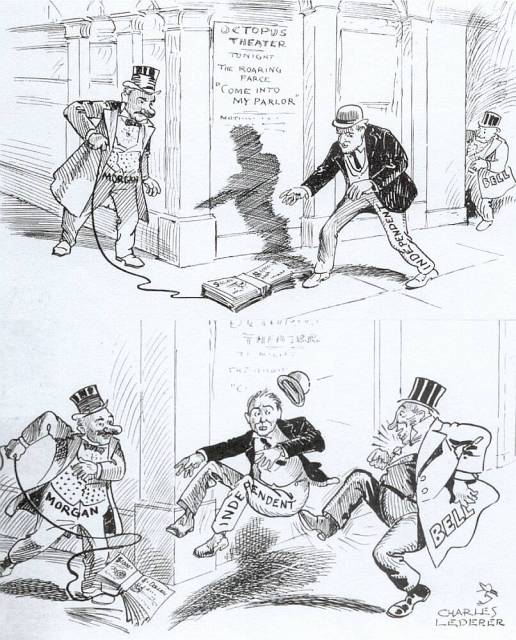
Not until the late 1960’s “Carterphone” case and the formation of
Microwave Communications, Inc. (MCI) with its microwave network between Chicago
and St. Louis did the ATT empire begin to crumble; its breakup came in 1984
almost by accident during Reagan administration miscues following 15 tumultuous
years of regulatory and legal battles.
(Source: Contrived Competition, pp 191-93, 196-210)
The breakup just as easily could have occurred in 1913-14,
unfreezing seventy ensuing years of cloistered innovation. Recall President Wilson’s admonition: Monopoly stifles invention. Unfortunately for Montana and America, the
die had been sealed when this President naively bumbled the implementation of
his well-conceived theories. The
initial public policy implementation of the Kingsbury letter would come several
months later in 1914, back in Judge Bean’s court at Portland, Oregon.
A New York Times headline on March 27, 1914 announced: “Phone Trust Dissolved. Pacific Northwestern Bell System Concedes
Government’s Demands”. A decree had
been filed in Judge Bean’s court the day before, signed by 28 of the 42
original defendants, the other 14 being dismissed as minor defendants
originally named so as to extract their testimony. (Source: 45A)
Overspent and Lost
in the Shuffle
The decree significantly
addressed the Bell/ICTC ownerships of The Home Telephone Company of Spokane and
the Interstate Consolidated Telephone Company Limited, the ICTC toll company
subsidiary. The Bell conglomerate was
ordered to divest these two companies within six months as to the former, and
within three months for the latter. These findings begged for similar
consideration of the Montana situation. (Source:45A)
Alas, the Montana companies controlled by Bell/ICTC were not
mentioned. This left the ownership of
the following former Bell competitors in Montana, which had not
physically been united or consolidated with Bell, illicitly in the hands of the
Bell conglomerate: An Automatic Company in both Helena and Great Falls, the
Billings Mutual (Automatic) Telephone Company, the Montana Independent
Telephone Company (MITC) at Butte, Anaconda, Missoula and Hamilton and the
State Telephone and Telegraph Company at Bozeman and Livingston. These companies encompassed nearly forty
exchanges in Montana.
The fate of the Spokane Home Telephone Company would take many
twists and turns over the next few years; Judge Bean uniquely had provided the
Spokane community the option of retaining Bell system ownership of the Spokane
Home company. Its city council was
required to make a decision within three months of the decree. The Council
sensibly elected to retain the Bell systems 22,000 telephones; the Spokane Home
Company’s 7,000 telephones could be merged.
After the decree was modified, several finger pointing back and forth
franchise discussions were held by the city council, alternately favoring
Spokane Home and its parent Bell company.
Given the common ownership, it seems curious that the Spokane city
government was so taken up in the matter.
(Sources: 54A, 61A)
On the other hand, Montana communities, especially those where
Independent telephones were equal to or far greater than numbers of Bell
telephones, were not given any options.
Beyond individual communities, the whole of Lane’s Montana Independent
interconnected system could have been given the choice to continue on as the
growing, perhaps dominant, technological superior. The PSC, with its statewide reach, and other relevant
considerations mentioned above could have been considered to allow development
of an even more robust, competitive, interconnected telephone system to develop
in the State.
Montana communities simply
were un-represented by the central Montana body politic in the most important
state and national telecommunications matter up to that time, with
ramifications in seven future decades.
The Montana federal district court, which had shown good understanding
of telephony, easily could have been petitioned if jurisdictional issues
somehow were held up as lame rational for the lackadaisical inaction. The newly sworn-in Attorney General in early
1915, Joseph Poindexter from Beaverhead County, and perhaps outgoing AG D.M.
Kelly, likely played a part in the inaction.
Mountain States Telephone and Telegraph (MSTT) was of the opinion that
if a suit were to be brought by the AG regarding Montana’s constitution, it
could unravel MSTT’s very expensive investment in the Lane companies. One step taken to prevent such action was
expressed by MacGinniss to Bell attorney Milton Smith on July 3, 1915 in a
letter discussing legal strategy: “I
will visit Helena in the near future and will renew my acquaintance with the
new Attorney General.” (Sources: 102,
103)
With few other options due to Bell ownership of both companies in Butte,
where this Montana adventure had begun, a telephone committee of the chamber of
commerce arranged a conference in June 1914 to discuss merging the Montana
Independent Telephone Company (MITC) and Bell, which were non-competing, but
separate companies. Potential cost
savings and modern innovation, without an advocate, no longer outweighed the
inconvenience of two non-connecting telephone systems. (Source: 55A)
By August, the journal Telephony reported an “understanding”
between the chamber of commerce and MSTT:
Dual telephone service would be eliminated by February 1, 1915. Until that date, and thereafter if the
deadline wasn’t met, a 50% credit would be given by MSTT to customers
subscribing to both systems. (Source: 56A)
The final flicker in the
competitive flame came in a spring 1915 lawsuit against MSTT, Lane and
others. Patrick Wall wanted Montana’s
constitution and statutes prohibiting common ownership of competing telephone
companies to be applied to the MITC-MSTT situation. In response, District Court Judge Lynch issued a restraining
order prohibiting the removal of the MITC automatic dial telephones. MSTT successfully sought to have all Butte
judges disqualified and Judge Poindexter (just before he became the Attorney General
on May 31st) brought to Butte from Dillon.
The case, along with several other similar actions, was settled between
the parties with an unknown monetary retainer paid to Wall and other
plaintiffs. (Sources: 38A, 57A,
102) Read the April 13, 1915 memo to
MSTT President E.B. Field detailing the various cases and options at this link:
Milton Smith Memo
The November 30, 1915 PSC annual report reflects none of the Lane
companies remaining in business; rather, Montana revenues of $7,254,110 were
vested in MSTT. One year earlier on
November 30, 1914 before MITC had been merged into MSTT, the former’s annual
revenues were reported at $3,641,511.
It is apparent that this number includes only MITC, since the Helena,
Great Falls, Bozeman/Livingston and Billings companies were not shown in the
November 1914 report; their finances had been combined with MSTT by that
date. In April 1916 Judge Michael
Donlan of Butte signed the formal order allowing MITC to dissolve and
disincorporate….one decade after its optimistic formation. (Source: 87) (Link
to Footnote M) M1
MSTT would not soon forget the money it poured into Montana in the form of excessive payments to quash and eliminate the competition from Lane’s Montana companies. It quantified the following in January 1915: total amounts spent; the actual or real values of the properties; and, its overexpenditure, a staggering $55,350,000 in current day dollars. The table following itemizes these categories for each of the Lane Montana companies, first in 1915 dollars and then in 2011 dollars (in parenthesis). Not included are excessive amounts paid for Interstate Consolidated Telephone Company holding company securities, i.e. 75% of the payment of $1,454,400 ($34,800,000 in 2011 dollars) paid to Lane/MacGinniss, or amounts paid later in 1915 to plaintiffs, such as Patrick Wall, to settle legal actions (Source: 99):
|
COMPANY ____________ CATEGORY |
Montana Independent Telephone Company |
Billings Automatic Telephone Company |
Helena Automatic Telephone Company |
Great Falls Automatic Telephone Company |
State Telephone and Telegraph Company |
TOTAL AMOUNT OVERSPENT |
|
TOTAL SPENT |
$1,864,409 ($43,100,000) |
$383,952 ($8,870,000) |
$337,744 ($7,800,000) |
$547,192 ($12,600,000) |
$502,125 ($11,600,000) |
|
|
ACTUAL VALUE |
$766,890 ($17,700,000) |
$175,039 ($4,040,000) |
$87,968 ($2,030,000) |
$155,137 ($3,580,000) |
$54,965 ($1,270,000) |
|
|
AMOUNT OVERSPENT |
$1,097,519 ($25,400,000) |
$208,913 ($4,830,000) |
$249,776 ($5,770,000) |
$392,055 ($9,020,000) |
$447,160 ($10,330,000) |
$2,395,423 ($55,350,000) |
Perhaps partially to assuage this overwrought investment scenario,
and to close out the affair, MSTT attorney Milton Smith recapped the purchase
of the Montana companies in a May 3, 1916 self-congratulatory letter to his
superior, MSTT president E.B. Field. In
it he thanked Field for adopting his recommendation in late 1911 vesting
authority for the Montana situation mostly with himself because “to
successfully accomplish the result would require one course of procedure
followed by one person…”. He continued
by expressing resentment regarding the antitrust case, and perhaps ATT’s
Kingsbury Commitment response to the case:
“It has taken a considerable length of time to accomplish all of this,
and it has not been without some trouble and annoyance, and without some litigation;
but, as you well know, it would have been accomplished long ago had it not been
for complications which arose in New York, caused by the attitude of the United
States government.” He ended the letter
with a self directed ‘atta boy for a job well done in a matter that “was a
great undertaking, and involved some considerable risk.” Nathan Kingsbury also would address a letter
to Field in which he addressed the end of the Montana matter with “much
interest and satisfaction”. He
concluded his Montana comments stating:
“I will certainly look up Mr. MacGinniss—I think he usually stops at the
Biltmore---and express to him my appreciation of his conduct.” (Sources: 100, 110)
The sun had set on the competitive information age in
Montana. The great spurring on by
competitive forces of increased access to telephone service, innovation and
higher levels of capital deployment in Montana were laid aside. Only Great Falls and Billings would retain
Strowger’s innovations of automatic switching and dial telephones---due to
special circumstances. The other
thirty-five Montana communities lost for decades any chance of seeing the less
expensive, more convenient and private method of connecting with ones friends,
relatives and business associates.
Their technological staple would be monopoly provided, cord-board,
operator-assisted calling. (Some of the
automatic equipment from Butte, Helena, Missoula and Livingston was used to
repair and expand facilities in the two automatic exchange cities.) Butte would not see automatic service again
until 1929, while over 40 years lapsed before dial telephony was re-introduced
at Helena in 1954-55. (Sources: 22, 86)
(Footnote N) N1
As for innovation and ensuing Bell capital deployment in Montana,
a discouraging but appropriate example would be MSTT’s substandard eight-party
service in rural areas: it would
persist into the 1980’s. Also indicative of Montana’s low position in the
pecking order for capital deployment: the last long distance toll cordboard in
the whole of the Bell system was scrapped from service at Great Falls on August
4, 1983, ironically just as the Bell system breakup was occurring. (Pictured below is a similar cordboard
switch retired circa 1980 from the Billings exchange, and retained for the MSTT
museum. The woman certainly is not
dressed in a 1980 era outfit.)
(Sources: PSC party-line records, THG Museum in Denver) Links to footnotes O through Q: (Footnote O) O1 Footnote P) P1 (Footnote Q) Q1
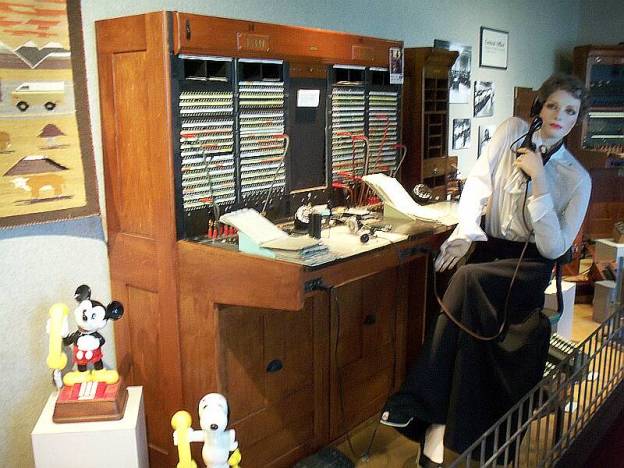
Epilogue
At about the time President
Wilson wrote on the subject of how monopoly power stifles innovation as quoted
before the prologue, the Bell system was attempting (unsuccessfully) to
purchase the Automatic Electric Company (AEC), not to foster competition, but
to stifle it because converting to automatic switches would render obsolete
Bell’s $300 million nationwide investment in manual switching equipment. Writing off its investment in manual
switching equipment would have been very detrimental to ATT’s earnings.
(Sources: 25C, Network Nation pp. 355, 384)
Another factor working against Bell owned AEC equipment in Montana
was the Bell system fixation to use equipment manufactured by its own
subsidiary companies; this was another profit center. Bell manufacturing, as in Western Electric Company, had no viable
automatic equipment to offer. If AEC
equipment needed upgrading or maintenance, MSTT would be forced to acquire it
from AEC; this was anathematic to Bell.
Only after an April 1919 operator strike in Boston exposed its
vulnerability to labor demands did the Bell system finally contract with AEC
for automatic switching, which was implemented slowly over ensuing years. (It
had acquired manufacturing rights for Western Electric in 1916, see Bray’s
Innovation.) (Source: 4)
As the Wilson Administration
was endorsing the Kingsbury Commitment in December 1914, it was simultaneously planning
for legislation to augment the Sherman Antitrust provisions enacted in
1890. It desired a complimentary, but
proactive law that would curtail monopolistic organization in its youthful
stages. Undoubtedly it wanted calm
legislative waters when it proposed its new theoretical framework, which
perhaps explains the Kingsbury settlement only five months after the ATT
antitrust case had been initiated. A
month after Kingsbury as legislative drafting was being finalized, the
President wrote: “The antagonism
between business and government is over.”
When President Wilson signed the Clayton Antitrust Act into law nine
months later in October 1914, he attached an inscription that was remarkably
ironic for telecommunications in Montana and America: “It is our purpose to destroy monopoly and maintain competition
as the only effectual instrument of business liberty. We have seen the nature and the power of monopoly exhibited. We know that it is more apt to control government
than to be controlled by it; for we have seen it control government, dictate
legislation, and dominate Executives and courts. We feel that our people are safe only in the fields of free
individual endeavor where American genius and initiative are not guided by a
few men, as in recent years, but made rich by the activities of a multitude, as
in days now almost forgotten.”
(Sources: American Review of Reviews, Feb 1914 pp. 135-140; Nov 1914 p.
533) (Link to Footnote R) R1
With monopoly reigning in
Montana telephony, the arcane, politically driven world of public utility
regulation became competition’s surrogate.
To establish the plodding paradigm following the events prior to 1916,
Bell took several years to sell itself to the public and calm the waters; meanwhile
PSC regulatory efforts were smallish, consistent with its resources. Following a failed WWI experiment when
Postmaster Burleson temporarily managed American telecommunications, Bell,
early in the 1920’s, ushered in its golden decades of monopoly power in
America. In Montana, House Resolution
#10 was passed by the Legislature on February 8, 1923 to spur a somewhat
resentful and overworked PSC into a full-blown investigation of MSTT “initial”
rates; docket #835 went to hearing in
November, and was decided February 26, 1924.
The familiar Milton Smith was Bell’s attorney. An overwhelming ninety-nine volumes of MSTT prepared property
appraisals were entered into evidence to be evaluated by the PSC’s lone,
short-tenured staff engineer in a regulatory process premised upon current
market values, rather than original costs.
Given the parameters, the case predictably showed that MSTT had been
operating at a deficit since 1916. The PSC found the expensive “license fee”
levied against MSTT by parent/affiliate ATT-Western Electric to be in the “best
interests of the company and its patrons”.
It formally blessed a value-of-service rate design scheme proposed by
MSTT, which used population and convenience as parameters, rather than specific
costs. Within this framework, up-charges
were approved for customers in the remaining automatic (dial telephone)
exchanges from the Lane years--for a service that actually cost less to
provide than manual cord board operator service. The automatic exchange up-charges were: 20% more for single party residential, and
75% for single party business. This
stroke of the pen in the PSC’s order ironically provided a disincentive to
customers for the dial service, while simultaneously it would provide excessive
returns to monopolist MSTT when it upgraded to automatic dial telephone service
in the future. (Implementation of new
rates was delayed due to a poor Montana economy in 1924.) (Sources: 95, 17 Mont Utility Reports, pp.
541-666)
While value of service
upcharges are not a good proxy for the competitive marketplace in the context
of ratemaking, they are somewhat useful to this historical narrative in that
they at least partially quantify the value of automatically switched dial
calling compared to operator-assisted cord board calling. Although docket #835 supporting
documentation was discarded by State government many years ago, it safely can
be said that the transcript of the hearing would have included testimony from
MSTT establishing the value basis for the 20% residential upcharge and the 75%
business upcharge. The PSC’s order approving
these upcharges simply confirms and quantifies monetarily the increased value,
and lost opportunity, of Lane’s automatic dial telephony to the telephone using
public in Montana. If the competitive market had prevailed, the public would
have benefited from these increased intrinsic values plus lower
telephone rates due to the lower costs of providing automatic service compared
to manual operator service.
Thaddeus S. Lane’s future, mostly in Spokane in subsequent years,
was a prosperous and successful one. He
actively was involved in many activities including: Mining ventures; the 22,000 acre 1,000 cow Pleasant Valley Ranch
development forty miles west of Kalispell; an unsuccessful attempt to purchase
for $79,000 the bankrupt Billings Gazette formerly associated with P.B. Moss;
unsuccessfully planning with MacGinniss to build the two million dollar Utah
Interurban Electric Railroad Company between Salt Lake City and Payson (in
competition with Walter Orem); forming with two others the National Parks Highway
Association to demonstrate poor roads in the Northwest; president of the
Spokane Chamber of Commerce; rumored candidate for governor as encouraged by
Seattle mayor Ole Hanson; helper in the Boy Scouts movement; and, in many
Spokane area sports related activities, such as auto racing in the Thaddeus
Lane 50 Mile Trophy Cup to benefit Red Cross, the Thaddeus Lane International
Trophy for polo, president of the Spokane Arena Company where professional
hockey was played and chief admiral in the Spokane/Coeur d’Alene Regatta Day
club. (Source: 60A)
T. S. Lane, always the master in his endeavors, adroitly used the
opulent personal gains he won in the telephone industry to polish away the
tarnish in his beloved community of Spokane.
He had achieved his own version of The Great Gatsby life. Hard working Montana folk, the solitary
heroes in this tale, simply were his unwitting financiers and accomplices. (Footnote S) S1
-------------------------------------------------------------------------------------------------------------------------
Stowger was an
excellent New York State university student, served in the Civil War from 1861
to 1865, taught school in Kansas and Ohio, and finally became an undertaker in
Topeka and Kansas City. Source: Swihart, Stanley. "The First Automatic
Telephone Systems" Telecom History: The Journal of The Telephone
History Institute No. 2. Spring, 1995: 3
(Return)
Research points to a
telephone franchise awarded by the city of Billings to a group of small
businessmen in October 1894. A company
was formed which at least planned the exchange construction. Bell bought out the stockholders in April
1901. The Dunlap Telephone Company in
Great Falls at the turn of the century, also purchased by Bell, is another likely candidate. It was Bell’s practice to advertise such
purchases as Independent company failures.
(Source: 98) (Return)
Over time, other
monies would be raised through what were known as subscription stock sales (a
promise to purchase securities while plant and equipment are being constructed
and installed) arranged by salesmen, either at company offices or
traveling. A directorate and initial
investor base of important citizens, hyped publicity and financial statements
appearing on their face to be solid would lure mostly small investors, many of
whom also would use the telephone service of the company in which they were
investing. Sources: 9, 13A, 13B, Network Nation p. 322 (Return)
For example, the construction estimate for the initial Great
Falls Automatic Telephone Company (GATC) facilities likely was $105,000 to
$110,000. The Montana Engineering
Company assumed some degree of risk in construction, and its payment was in the
form of GATC securities for resale, payable after construction completion (GATC
would not directly sell securities): 18,000
shares of voting no-par “bonus” common stock, 1,000 shares of interest bearing
cumulative 7% preferred stock with a $10 par value and 350 bonds bearing 6%
interest with a face value of $500. From
a Montana Engineering perspective, the bonds likely were taken assuming a 45%
discount to cover construction risk, external financing needs during
construction and selling costs. The par
value of the preferred stock of $10,000 plus the discounted face value of the
bonds of $96,250 approximated the total value of the $106,250 construction
project. The owners of the construction
company, Lane, Jackman and Wall from Butte along with Couch, Durrett and
Stanton from Great Falls, each purchased from the construction company a mix of
the securities at the initial unit values above mentioned. This infused just enough cash so as to start
construction. One or more of these
owners may have attempted to borrow this “infusion” money from a friendly bank
by using the very same securities as collateral, perhaps at inflated values. Suppliers selling goods on credit for the
construction project, such as automatic switching from AEC, also provided
indirect construction funding. Savvy
creditors may have required personal guarantees from the owners.
Once construction
began, the project was hyped to the public as a viable and valuable project
with a well-respected board of directors and investor group. This allowed for inflated-value subscription
sales of preferred stock and common stock, with the six men above retaining the
bonds due to their first creditor position.
The stock certificates transferred to small investors included the
clause: “This preferred stock is
subject to redemption by the company at $110 per share, and accumulated
dividends…” By introducing this price
dynamic, the preferred stock could be hyped to a public fed up with RMBC service,
and then sold for $100 share with a 100% common stock bonus. Just a few of these sales were needed to
establish an “initial offering” market price of $100, thereby allowing a 1,000%
markup to be recorded on the construction company books. The $10 par value became a $100 market
value, with the balance of the $110 amount being ascribed to establish a market
value of $10 for the common stock, an increase from $0 to $10. With the new values of the stock, the
rational for the bond discount was erased, thereby allowing the bond face
values at $500 to be valid. These much-inflated
values then were recorded into plant values on the books of GATC.
So with a few pen
strokes and a bold plan, the construction company owners had amassed a dramatic
profit margin to show potential financiers for the next exchange project. At least on paper, the $106,000 construction
contract was translated into a $455,000 value. If securities sales proceeded as
hoped, which they did not for Montana Engineering and indirectly GATC, the
paper profit would have become a solid, convincing value to potential
financiers. Sources: 113, Stock certificates owned by the author,
Thomas Couch, Jr. papers, Mansfield Library, University of Montana, and Review
of Reviews, February 1910 p. 246. (Return)
On August 7, 1907
Judge Hunt issued a temporary restraining order In Rocky Mountain Bell
Telephone Co. v Montana Federation of Labor.
He held that the Labor organization acted in what was tantamount to a
conspiracy when it posted circulars. A
typical circular specified the following:
“Don’t Patronize
The Bell
Telephone Company. Is is unfair to
Montana Federation of Labor
The girls are on
strike for living wages in the following places: Billings,
Red Lodge,
Livingston, Bozeman, Lewistown, and Great Falls.
The company is
offering inducements to ‘scabs’ advertising in the papers
to pay board and
room in addition to wages.
Don’t disgrace
your sex. Keep away. We will win, or put the corporation
out of business. We ask your help in this fight. Humanity demands it.”
In part, the Judge’s
decision was based on the report of special master-in-chancery, O.T. Crane, who
found the union activities significantly had damaged RMTC’s business.
In another legal
proceeding, District Court Judge C.T. Bach of Helena ordered Rocky Mountain
Bell, which had closed its offices, to reopen them: “…as a public utility
corporation, it must operate its lines regardless of the cost involved”. Sources: 73, 156 Fed 809-822, 75 (Return)
Since automatic dial telephones do not
require an operator, a tone system was developed to indicate to the caller the
progress of his or her call. The distinctive
tones were produced by what is known as a Ring Generator, which was an
electromechanical device. The tones
commonly were known to the public as Dial Tone, Busy Line Tone, Ring Tone and
Number Not Available Tone. A very good
demonstration of these tones unique to the Strowger automatic switch can be
heard at the web site: www.seg.co.uk/telecomm/sounds.htm (Return)
It wouldn’t be long before Bell would retaliate by offering
free service to some if not many Buttians “for practically an unlimited
period”. This forced MITC to
disconnect service and seek judgments in court for amounts due. Clearly this constituted illegal predatory
pricing in violation of antitrust law.
Source: 68 (Return)
As the new exchange
opened, Thaddeus Lane had replaced Utah’s Elmer Jones in the role of managing
director. The journal Telephony in 1911 exposed the 1907 activities of Jones
and Utah Independent Telephone Company as being secretly controlled by the Bell
system, thus enraging Utah citizens. Source:
24 (Return)
A reason MacGinniss
was featured prominently in the ICTC sale to MSTT’s Corporation Securities and
Investment Company is that he resigned all his positions with the Lane
companies just prior to the contract signing in 1912; the contract was signed
with him. The delivery of ICTC securities
was channeled through him in a legal slight of hand. President Lane, if pressed under oath, would have been able to
testify that he at least tactically wasn’t involved at the time control
passed to MSTT’s subsidiary. Documents
proving his strategic involvement would be unavailable until years
later. Sources: 71, 38A pp. 33-34. (Return)
It was reported that the PSC did hear the matter in late
October 1913, apparently with no resulting order. Source: 43B (Return)
The PSC annual report,
1914-15, in Farmers Committee v. MSTT (heard April 7, 1915; decided July 26,
1915) included a reference to the competitive period between Billings Automatic
(Mutual) Telephone Company (BMTC), a Lane company, and MSTT. It’s order: declared invalid pre-existing
discriminatory toll price contracts; took notice of the competitive period
between BMTC and MSTT (RMBC) and most importantly, took notice of the
acquisition of the lines and equipment of BMTC rather than the company
as an entity. (Return)
An esteemed economist specializing in telephone companies and
regulation would write in 1994 of the “natural monopoly” argument: “By contrast, the review of AT&T’s conduct
from 1894 to 1910 presented in this article suggests that the monopoly
structure of the telephone market was not merely the result of “technological
and economic imperative,” (as was asserted by AT&T) but also resulted from
such Section 2 (Sherman Antitrust Act) violations as predatory pricing, funding
of court cases in order to interfere with price increases granted to the
Independent by municipalities, acquisition of manufacturers of telephone
equipment in order to limit the Independents’ access to the capital markets, and
bribes or threats to financiers to discourage financing of the
Independents.” He ascribed the
Independents’ demise to “more than anything else to predatory actions by
AT&T.” Source: David Gabel,
Competition in a Network Industry: The Telephone Industry, 1894-1910, The
Journal of Economic History, vol. 54, #3, pp. 545, 569. (Return)
Months in which the
following automatic exchanges were connected with or combined into MSTT:
Helena, Great Falls and Livingston—September 1914;
Billings—October 1914; Butte and Missoula—October 1915. Source:
17 Mont Utility Reports p. 554. (Return)
Automatic dial service
was retained in Great Falls because of the efforts of the Fligman
committee. The two exchanges were
interconnected in 1912 due to the committee’s active role. After interconnecting, call volume increased
dramatically. This successful
experience necessitated installation of more automatic equipment, likely from
the Livingston exchange, then perhaps from the Helena exchange. In Billings, interconnection of the manual
Bell exchange and the older technology three wire automatic service was “made
possible by the recent settlement of litigation started by P.B Moss, who was
heavily interested in the automatic system and originally installed it in
Billings, against some of the men who sold the automatic system to the Bell
interests, whereby Mr. Moss received in settlement of his claims $336,000”. It
is very probable that equipment taken from the Butte automatic exchange was
used in Billings, since it also was a three-wire exchange. Sources: 22, 86, 92, 93, 111 (Return)
Symbolic of the new monopolistic telephone industry paradigm
in Montana was the complaint filed with the PSC in March 1915 by W.E. Carroll,
a man who later would become a District Court Judge in Butte. He alleged MSTT had “increased its rates in
Butte over the schedule on file with the commission and that the increase is
unjust and discriminatory.” How the
complaint was settled is lost to history.
Source: 72 (Return)
Tim Wu’s recent book, The Master Switch, also is relevant
reading regarding innovation and monopoly.
One reviewer recapped a part of this conundrum as follows:
“The histories Wu relates are unexpectedly fascinating, partly
because fierce conflicts make for good stories and partly because they invite us
to imagine such scenarios as what the world might have looked like if Bell
hadn't postponed the introduction of innovations like voice mail, fax machines
and modems for so long. Mammoth communications monopolies might be stable, Wu
points out, and they do encourage the development of new ideas that stand a
chance of enhancing their current business, as in corporate-sponsored hotbeds
like Bell Labs. But they also reflexively shut down anything that threatens to
usher in …….. true innovation. A form of irrational ‘paranoia’ (Wu's term)
caused Bell to stifle the invention of magnetic recording tape by one of its
engineers in the 1930s -- somehow they thought it would ‘lead the public to
abandon the telephone.’" Laura
Miller at www.salon.com
, December 29, 2010 (Return)
In the category of
“life imitates art”, a play called “Bought and Paid For” toured Montana in
1914. Its story features a young
“telephone girl” who marries a millionaire.
She soon finds him to be a drunken brute, and locks herself away. He breaks down her door to tell her she
can’t refuse him because she is “bought and paid for”. After more travails in which he says he
can’t reform, the couple in the final act reconciles to work out their
difficulties. A Tale of Two Telephones, save the final act, has certain
parallels. (Pictured below is an
account of the play from the Livingston Daily Enterprise January,12 1914.) Source:
88 (Return)
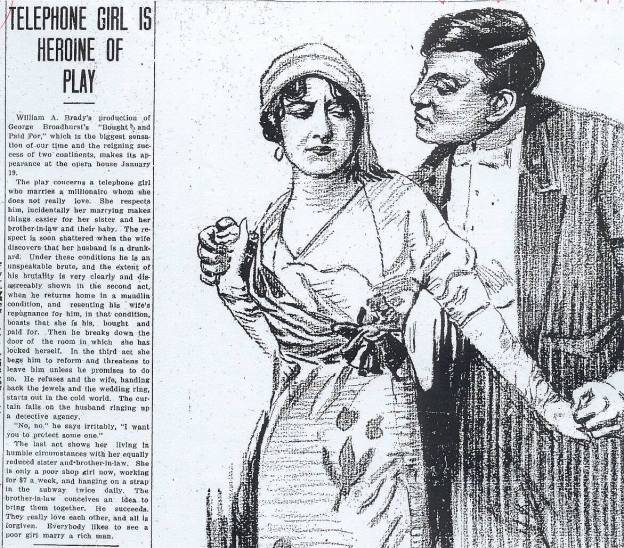
The Clayton Act embodies the Wilson Administration’s effort to
close loopholes in the Sherman Act by among other things, shifting the burden
of proof to the accused and providing treble damages. It’s genesis in late 1913 and 1914 also may have considered the
political repercussions of personally prosecuting many powerful business
leaders for potentially illegal activities brought to light in the ATT
antitrust case hearings. (Return)
Current relevance brings meaning to the study of history. A recent Montana meltdown replayed a main
underlying theme in A Tale of Two Telephones, that being the abuse of monopoly
power.
Unfortunately
for folks in Butte and Montana, another telecommunications-information
age-monopoly fiasco played out in their theatres just ninety years following
Kingsbury when a Montana Power Company (MPC) affiliate named Touch America went
bust. Slick New York investment bankers
spin-doctored gullible young top executives into peddling MPC’s
electric-monopoly generating assets to a Pennsylvania company. (This portfolio, which long had been the
state’s largest and most inexpensive for a wide swath of MPC consumers, quickly
became quite expensive.) The proceeds
were used to finance an all-in gamble in the overbuilt telecommunications fiber
optics market in which Touch America specialized. Overly political, too-quick-to-act and errant Montana elected
officials by the score were complicit through legislative action in 1997 that
facilitated the sale of the electric monopoly assets. Six years later, Butte based Touch America declared bankruptcy.
The losers each month when they pay their electric bills are hard working
Montanans. (Return)
Common lore credits Professor Alexander Graham Bell of Boston University as the inventor of the telephone since it was he who was granted on March 7, 1876 a seventeen year patent for an improvement allowing telegraphic transmission of human speech. Such transmission was by “undulatory currents” analogous to the undulatory rhythm of the human voice, and was accomplished by inventing a transmitting device with variable electrical resistance. The next year on January 30, Bell received a complementary patent for an improvement to the “electric telephone”. Bell exhibited the talking telegraph at America’s Centennial Exhibition in Philadelphia, but found few parties interested in his freshly hatched novelty. (Pictured below is A.G. Bell with a telephone similar to that which he exhibited at the Centennial Exposition.)
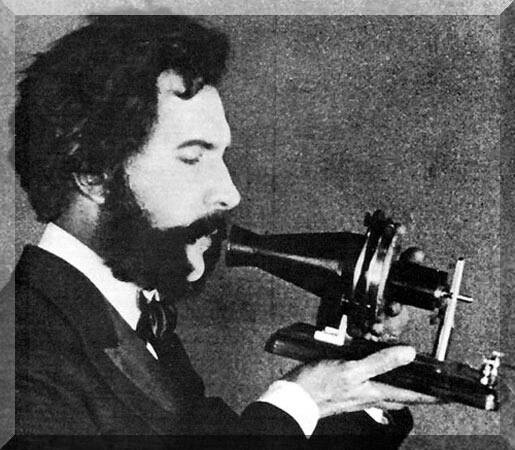
The field of voice telegraph was by no means exclusively Bell’s in
1876. Names such as Johann Reis in 1861, Antonio Meucci in 1871 and
especially Elisha Gray in 1874 to this day receive credit in the
invention. Lack of practical interest, money pressures and early
potential patent issues played a part when Bell offered, also in 1876, to sell
his original patent to Western Union for $100,000. An internal Western Union
memo recommended against the purchase specifying that Bell’s device sadly was
deficient in its technological and practical capabilities: “Furthermore,
why would any person want to use this ungainly and impractical device when he
can send a messenger to the telegraph office and have a clear written message
sent to any large city in the United States?” The sale was not
consummated.
On July 9, 1877, Bell and his wealthy father-in-law as of July
11th, attorney Gardiner Greene Hubbard, formed the Bell Telephone
Company. Of critical importance the same year, they chose to lease
telephone instruments in conjunction with providing telephone service, rather
than selling telephone instruments. Therefore, Bell Telephone Company was
a telephony leasing and service company, rather than a retailer of
telephones. This metric defined the industry structure until 1984.
In its October 6th, 1877 issue, Scientific American
featured Bell and his telephone, specifying it had “advanced considerably
beyond the status of a beautiful scientific toy….”. Even popular
press like Scribner’s magazine would laud the benefits of the telephone within
the next year. The telephone had found
its legs in the scientific community, and with nearly one thousand early
customers on the east coast.
The next year on February 12, the Bell Telephone Company was
reorganized, this being of vital importance because the elite Boston
venture-capitalists assumed a controlling interest. Theodore Vail,
formerly a railway mail service clerk, was its general manager. (Vail’s
first cousin, Alfred, was instrumental in assisting Samuel Morse when he
invented the telegraph.) Another
reorganization in 1879 resulted in the National Bell Telephone Company, the
President of which was Ralph Waldo Emerson’s son-in-law, capitalist William H.
Forbes. A third reorganization in 1880 established the overarching
holding company, American Bell, which controlled all business operations and an
expanding portfolio of patents. Bell himself would resign his director position
in 1880, with Forbes and his wealthy partisans in firm control. American
Bell acquired in 1882 a controlling interest in Western Electric.
American Bell business strategy in the 1880’s was: to pay substantial dividends to its elite
Boston investors rather than reinvesting all monies into the growing business;
to always prevail in legal actions protecting its patent portfolio; and, to
structure its business to outlast inevitable patent expirations in
1893-94. Integral to these efforts
included: ongoing technological
improvements to its governmentally franchised local exchanges in large,
important cities where affluent customers were served; and, designing the
framework for a highly profitable, exclusive long-distance toll network
complimentary to its local exchange federation of companies. Manufacturing and leasing its telephones
continued to be important.
Patent lawsuits toughened Bell’s corporate mindset in the 1880’s
as it marched through the process of filing nearly six hundred infringement
actions. Stinging press accounts, like
those repeatedly printed by New York Times editor George Jones opining that
Bell’s patents “were fraudulent”, further seasoned Bell’s resolve. The royal donnybrook of its litigation
culminated at the US Supreme Court in 1888 with Chief Justice Morrison Waite’s
decision upholding Bell’s patents in the Court’s most technical and voluminous
case up to that time. Some suggested
stress from the litigation might have killed Waite; he died four days following
the decision.
The technological heart of American Bell local exchanges was the manual, or operator assisted switchboard. Its technology progressed during the 1880’s so that by decades end each operator could connect more calls, more quickly: The call connection delay early in the decade was five minutes or longer, but was reduced to forty-five seconds late in the decade by the “multiple” switchboard at which one operator could control many wires, or cords. (Pictured below is a Bell central exchange circa 1884.)
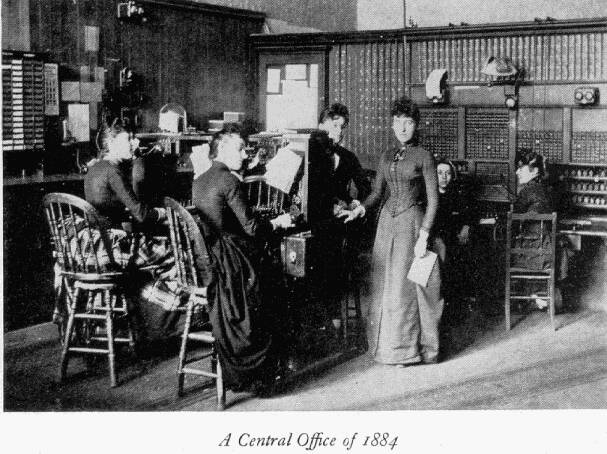
American Bell’s linchpin long distance toll business was carried
out by American Telephone and Telegraph (ATT), a subsidiary formed circa 1885
in New York to sidestep tougher corporate capital requirements promulgated by
Massachusetts. ATT’s formation embodied a peremptory strategy calculated
to protect the conglomerate when original Bell patents would expire in
1893-94: It would isolate Independent company local exchanges inevitably
that would attempt to form, many in smaller communities, because Bell would prohibit
them from connecting to ATT toll lines which exclusively served the Bell
federation of local exchange companies in large and important cities. In 1899, ATT would become the holding
company, replacing American Bell, as well as continuing to be the long distance
intertie or bottleneck, depending on one’s perspective.
(Return)
Sources:
2.
Scribners magazine, April 1878 pp 848-855
3.
Network Nation, pp. 201-234
4.
www.toptenz.net
5.
http://en.wikipedia.org/wiki/Alfred_Vail
Lane Automatic System sidebar:
Automatic telephone equipment used by MITC starting Sept. 1907 and
its sister companies in Montana were Strowger inspired and Automatic Electric Company
(AEC) manufactured. The long
manufacturing tenure of Strowger inspired equipment, which continued for most
of the 20th century, has been described as one of the longest in the history of
modern technological products. (Chapuis, 100 Years of Telephone Switching, Vol
1, p. 68)
The basic Strowger Switch is a “can” in which ten levels of ten
fixed contact points at each level are arranged in a semi circle. A carriage within the “can” moves up and down
within it to the appropriate level as determined by the number of electrical
pulses it receives from the originating device, a dial telephone. If one were to dial the number four, the
carriage would move to the fourth level.
When the next number is dialed, a “wiper” integral to the carriage
rotationally selects the appropriate contact in the fourth semi-circular level
of ten contacts. With its 10 x 10
arrangement, each “can” is able to connect 10 times 10, or 100 subscriber
lines. The addition of a second “can”,
which would be connected electrically to the first, theoretically could
expand the number of subscribers served to 100 times 100, or 10,000. Just two subscriber lines would be able to
connect at any given time in this impractical arrangement.
Other devices, which were invented to achieve a workable
switching arrangement, considered a countervailing dynamic: far less than 100%
of subscribers were simultaneous users. (Only 6 conversations per day per
telephone was the norm, of which only .16 were toll calls.) With this in mind
late in 1905, AEC engineer Alexander Keith made a most significant enhancement
to Strowger switching: His
plunger-based line preselector would very efficiently identify unused connections
over which to route calls in the second and higher levels of “cans” in the
decimal-based calling hierarchy. His
invention allowed Strowger switches first patented in 1891 to be installed in
medium sized and smaller communities as good, reliable automatic systems,
starting in 1906. (The systems also
were installed in large exchanges, such as those in San Diego, Los Angeles and
San Francisco.) Two-wire central
battery innovations at about the same time further increased system utility. (Pictured below are AEC automatic exchange
“racks” circa 1912.) Source: 23,
Technical narrative reviewed by an expert telephone engineer.
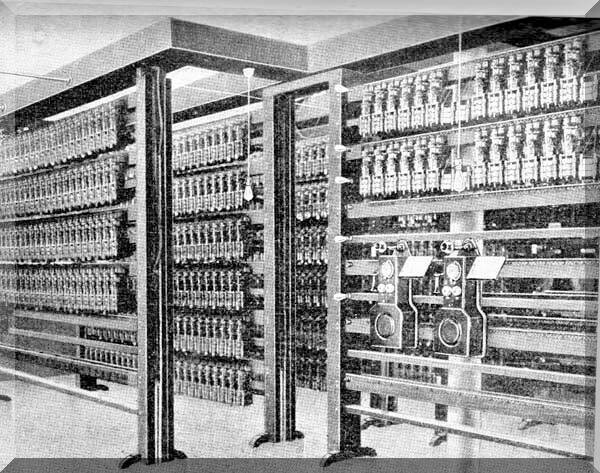
Technological timing for the
Lane Independent companies was very good, with Butte automatic dial exchange
construction commencing in 1906 and concluding as the exchange opened in
September 1907. The Billings Automatic
exchange followed a year later. These
two systems were three wire systems requiring callers to push a ring button on
their telephones after dialing; this action completed the call. Other automatic exchanges openings, late
1909 at Helena and within the first eights months of 1910 at Great Falls,
Missoula and Livingston, were of two wire design in which a ring button was
unneeded. Lane’s largest two wire
automatic exchange would be completed in Spokane. (The Treasure State full page spread, Helena exchange, December
1909)
Lane coordinated with well-known local capitalists in these cities so as to raise initial capital for exchange construction, and to sell securities to small investors in communities in which automatic exchanges were constructed. To lend a sense of permanence, city-center exchange buildings were constructed to be attractive, as well functional. For example, Lane specified for Helena’s exchange: “…I would be very much in favor of substituting this brick with terra cotta trimmings for the sand lime brick which we contemplated using. The use of white enamel brick would give us the most striking building in the City.” Well-known local architect George Shanley designed the Great Falls and Butte exchanges, the latter being designed in the grandiose and exuberant Beaux Arts style. (The Missoula automatic MITC exchange building is shown below, as of April 2012.) (Lane to Cook, Source: 14B)
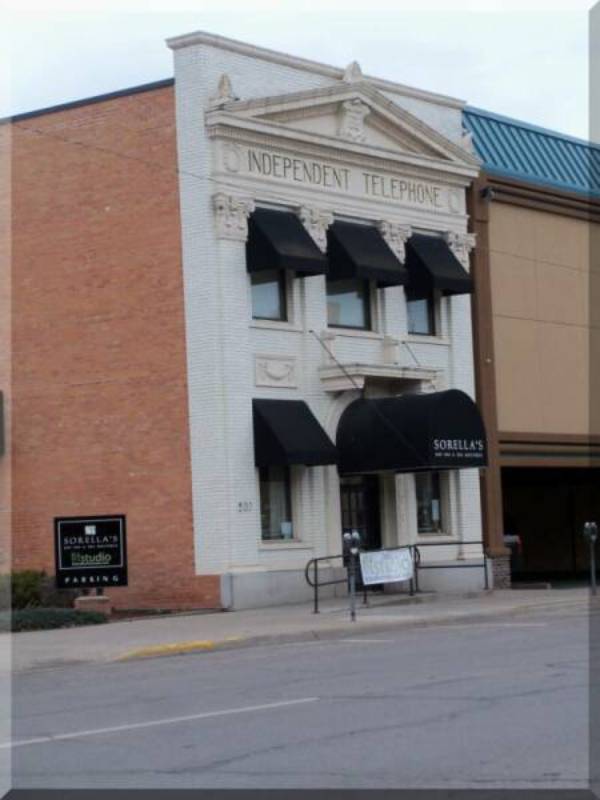
The significant availability in Montana of automatically
switched dial telephony by the end of 1910 moved the State from its second rate
status before 1907 into the vanguard of advanced telephony. Numbers of telephones world wide in 1910
were about 11,200,000, of which 7,596,000 were in the U.S. About 200,000 of these were dial models in
131 automatic exchanges, or slightly less than 2.7% of this U.S. total. Since Lane’s automatic exchanges were in
Montana’s major cities of Butte, Billings, Helena, Great Falls and Missoula, as
well as Livingston, it safely can be inferred that Montana’s populace was much
more highly served by advanced telephony than were other Americans. As important was Lane’s commitment to
dial phones and automatic switching; undoubtedly these would have spread to
other Montana communities, if given the chance to do so. Communities in Idaho
and Washington in which Lane was involved would have seen similar
progress. (Chapuis in 100 Years of
Switching, pp. 67,138)
Also significant during these years of automatic switching
deployment by the Lane companies in Montana was partial Bell reconstruction of
its Montana manually switched exchanges, done in part to incorporate central
battery systems, but also as a competitive response to Independent company
activity. The central battery allowed
old magneto style telephones with bothersome leaky batteries at customer
premises to be scrapped; it was a Bell initiative nationwide early in the 20th
century. Once these investments were made
(although in Montana recycled equipment was sometimes used from other RMBC
states), the central battery manual cord board exchanges would have been
reliable and uneconomic to scrap, unless ongoing competition forced better
technology to be installed. (Chapuis in
100 Years of Switching, p.149-150 and Source 111)
In comparing the two approaches to switching, the oft-updated
authoritative manual Modern America Telephony, In All Its Branches
included the following conclusion in its 1911-12 edition: “The chief disadvantages felt in manual
telephone switching were slowness in connecting and disconnecting, wrong
numbers, discourtesy and irregular attention to the want of subscribers,
evesdropping on conversations, and increasing cost of operation. Though the modern operator is as well
drilled as a human being of her capacity can be, much of the above trouble
still exists, for it is inherent in humanity.”
The early adoption of dial telephones and automatic switching in
significant areas of Montana began the process of ameliorating these issues.
